The Story of the New Testament
In Eternity God—Father, Son and Holy Spirit—in Eternity
In Eternity Father, Son and Holy Spirit
Apostle John: welcome to the New Testament
In Eternity God—Father, Son and Holy Spirit
God the Son existed beside the Father and God the Spirit in eternity
that
The Bible teaches that God the Son existed forever as God the Son in perfect fellowship with God the Father and God the Holy Spirit for all eternity. God sent the Son into the world to be born as a human baby, named Jesus. He sent His Son to deliver the human race from sin and eternal judgment.
Where it all began… The Son of God Came to His People
Where It All Began
The Apostle John Explains…
Where It All Began
Jesus came to John the Baptist to be Baptized
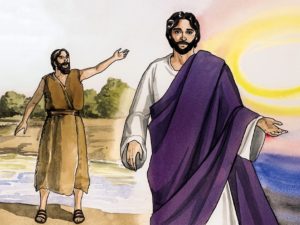 At the beginning of His ministry, Jesus came to John the Baptist to be baptized and then went into the wilderness to be tempted by Satan for 40 days. When Jesus came back from the wilderness, John the Baptist saw Him and told Andrew and another person that Jesus was the Lamb of God. Those 2 men talked with Jesus that evening and then quickly went to bring others to meet Him.
At the beginning of His ministry, Jesus came to John the Baptist to be baptized and then went into the wilderness to be tempted by Satan for 40 days. When Jesus came back from the wilderness, John the Baptist saw Him and told Andrew and another person that Jesus was the Lamb of God. Those 2 men talked with Jesus that evening and then quickly went to bring others to meet Him.
Where It All Began
Jesus selected his first disciples
 Andrew brought his brother Simon to Jesus. Jesus called Simon “Peter” which means “rock”. 2 years later, Jesus said this again. “You are Peter (the Rock) and on this Rock I will build my church”. This shows how God chose to use special people to establish His church. Jesus chose 12 men to serve as His specially appointed apostles, men who (except for Judas) would bring the Good News about Jesus Christ to people throughout much of the ancient world.
Andrew brought his brother Simon to Jesus. Jesus called Simon “Peter” which means “rock”. 2 years later, Jesus said this again. “You are Peter (the Rock) and on this Rock I will build my church”. This shows how God chose to use special people to establish His church. Jesus chose 12 men to serve as His specially appointed apostles, men who (except for Judas) would bring the Good News about Jesus Christ to people throughout much of the ancient world.
Where It All Began
Jesus was rejected by Israel
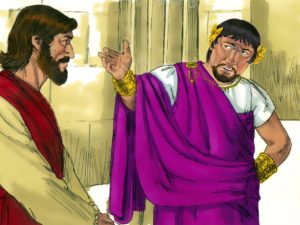 Jesus came to the people of Israel as their Messiah, just as the Old Testament prophets had predicted. Everything about Jesus fit what the prophets had said. The prophets had even predicted that the Messiah would come as someone who served others, but the people wanted a warrior king. They rejected him and the religious leaders arrested Jesus and condemned Him to die on a cross, in just way that the Old Testament prophets had said it would happen. But the people did not understand that the Messiah must first die for the sins of the world and then rise from the dead as a glorious King.
Jesus came to the people of Israel as their Messiah, just as the Old Testament prophets had predicted. Everything about Jesus fit what the prophets had said. The prophets had even predicted that the Messiah would come as someone who served others, but the people wanted a warrior king. They rejected him and the religious leaders arrested Jesus and condemned Him to die on a cross, in just way that the Old Testament prophets had said it would happen. But the people did not understand that the Messiah must first die for the sins of the world and then rise from the dead as a glorious King.
Where It All Began
Jesus was abandoned by His apostles
 On the night when Jewish leaders arrested Jesus and put Him on trial, all Jesus’ disciples ran away in fear. Simon Peter was waiting right in a courtyard outside the room where Jesus was being tried, because he wanted to know what was happening. As Simon Peter stood there, a servant girl accused him of being Jesus’ disciple and soon others agreed with her. Three times that night, Simon angrily swore he did not know who Jesus even was. No one defended Jesus and no one helped him.
On the night when Jewish leaders arrested Jesus and put Him on trial, all Jesus’ disciples ran away in fear. Simon Peter was waiting right in a courtyard outside the room where Jesus was being tried, because he wanted to know what was happening. As Simon Peter stood there, a servant girl accused him of being Jesus’ disciple and soon others agreed with her. Three times that night, Simon angrily swore he did not know who Jesus even was. No one defended Jesus and no one helped him.
Where It All Began
The leaders crucified Jesus
 The next morning, the leaders agreed that Jesus must die because He had said He was God’s Son. Just as the prophets said, they beat Him, mocked Him, pierced His hands and His feet, and hung Him to die. After 6 hours of horrible suffering on a cross, Jesus surrendered His spirit to God and died. He was buried in a tomb, guarded by soldiers.
The next morning, the leaders agreed that Jesus must die because He had said He was God’s Son. Just as the prophets said, they beat Him, mocked Him, pierced His hands and His feet, and hung Him to die. After 6 hours of horrible suffering on a cross, Jesus surrendered His spirit to God and died. He was buried in a tomb, guarded by soldiers.
After 3 days, The Son of God Rose from the Dead
Son of God Rose from the Dead
John, the witness to the resurrection
Son of God Rose from the Dead
Jesus Rose from the Dead
 But 3 days later, God raised Jesus from the dead. The risen Jesus first met several women who had come to his empty tomb. Then Jesus come to Simon Peter, the apostles, other faithful followers, His brother James and then even over 500 people. Jesus’ resurrection from the dead changed everything; everything in Simon’s life, everything in the life of all of Jesus’ apostles, even everything in the lives of those who came in contact with Him.
But 3 days later, God raised Jesus from the dead. The risen Jesus first met several women who had come to his empty tomb. Then Jesus come to Simon Peter, the apostles, other faithful followers, His brother James and then even over 500 people. Jesus’ resurrection from the dead changed everything; everything in Simon’s life, everything in the life of all of Jesus’ apostles, even everything in the lives of those who came in contact with Him.
Son of God Rose from the Dead
Many People Saw Jesus after His Resurrection
 How do we know that Jesus rose from the dead? All of these many, many witnesses were willing to give up their lives later on based on their claim that Jesus had come to them after His resurrection. Over the next 40 days, Jesus met with his followers several times and spoke many things about the Kingdom of God.
How do we know that Jesus rose from the dead? All of these many, many witnesses were willing to give up their lives later on based on their claim that Jesus had come to them after His resurrection. Over the next 40 days, Jesus met with his followers several times and spoke many things about the Kingdom of God.
Son of God Rose from the Dead
Jesus Went Up to Heaven
 One last time, Jesus met with them and told them to wait in Jerusalem—something was going to happen. “John baptized with water, but you will be baptized with the Holy Spirit no many days from now.” The disciples wanted to know if Jesus was going to be crowned as king and rule on His throne, but Jesus said, “It is not for you to know times or periods that the Father has set by His own authority. But you will receive power when the Holy Spirit has come on you, and you will be My witnesses in Jerusalem, in all Judea and Samaria, and to the ends of the earth.” Jesus then rose up from earth into the heavens.
One last time, Jesus met with them and told them to wait in Jerusalem—something was going to happen. “John baptized with water, but you will be baptized with the Holy Spirit no many days from now.” The disciples wanted to know if Jesus was going to be crowned as king and rule on His throne, but Jesus said, “It is not for you to know times or periods that the Father has set by His own authority. But you will receive power when the Holy Spirit has come on you, and you will be My witnesses in Jerusalem, in all Judea and Samaria, and to the ends of the earth.” Jesus then rose up from earth into the heavens.
Pentecost After 10 days: The Holy Spirit Indwelt and Empowered the Church
The Holy Spirit Came
John, the Witness of Pentecost
The Holy Spirit Came
The Apostles choose Mathias by casting lots which apostle replaces Judas
After Jesus ascended into the sky, the apostles decided they needed to replace Judas. Since this was before the Holy Spirit was poured out on them, they cast lots to choose the right person. A disciple named Mattias was chosen.
The Holy Spirit Came
God’s Plan: To send Christian Believers to All the Earth
 When Jesus had appeared to many people after His resurrection, He told them His plan: He was sending them out to every nation with the good news, the Gospel. They must all be witnesses to what they had seen and learned from Jesus’ teachings, His life, death, and resurrection. They must lead others to become disciples, baptizing them and teaching them to obey everything Jesus had commanded them. However, Jesus told His followers to wait until the Holy Spirit came to them.
When Jesus had appeared to many people after His resurrection, He told them His plan: He was sending them out to every nation with the good news, the Gospel. They must all be witnesses to what they had seen and learned from Jesus’ teachings, His life, death, and resurrection. They must lead others to become disciples, baptizing them and teaching them to obey everything Jesus had commanded them. However, Jesus told His followers to wait until the Holy Spirit came to them.
The Holy Spirit Came
The Holy Spirit Empowers and Sends out the Church
 50 days after Jesus Christ rose from the dead, God sent His Holy Spirit to the believers who were gathered together for prayer in Jerusalem. They rushed outside and began speaking God’s praises in many other languages. Simon Peter preached to the crowd which was gathered there and over 3 thousand people believed and were baptized. Jesus’ command—that they be witnesses—was already happening. This first step of God’s great salvation story began that day in Jerusalem. This day is called “Pentecost”, a word which means “fifty” for 50 days after Jesus’ resurrection.
50 days after Jesus Christ rose from the dead, God sent His Holy Spirit to the believers who were gathered together for prayer in Jerusalem. They rushed outside and began speaking God’s praises in many other languages. Simon Peter preached to the crowd which was gathered there and over 3 thousand people believed and were baptized. Jesus’ command—that they be witnesses—was already happening. This first step of God’s great salvation story began that day in Jerusalem. This day is called “Pentecost”, a word which means “fifty” for 50 days after Jesus’ resurrection.
The New Testament Story
The New Testament Story
Apostle John’s Explanation of the New Testament story
The New Testament Story
The New Testament Story
This is the New Testament Story, about the life, death, and resurrection of Jesus Christ. It is also the story of how God the Holy Spirit filled the hearts of believers in Jesus Christ and then sent them out into the world as witnesses to the world that Jesus Christ is the crucified and risen Son of God.

Earliest Christians Persecuted for their Witness to the Resurrection
Persecuted as Resurrection Witnesses
Apostle John Explains how persecution began
Persecuted as Resurrection Witnesses
Religious Leaders Tried to Stop the Apostles
 Peter and John arrested and released
Peter and John arrested and released
Before long, God began doing great miracles through these first Christians. Peter and John healed a man who had been crippled from his birth. When a great crowd gathered because of the miracle, they again preached the good news about Jesus Christ, but the religious leaders tried to stop them and told them not to speak or teach to anyone in Jesus’ name again. But Peter and John replied, “Do you think God wants us to obey you rather than him? We cannot stop telling about everything we have seen and heard.” The council then threatened them further, but they finally let them go because they didn’t know how to punish them without starting a riot. For everyone was praising God for this miraculous sign—the healing of a man who had been lame for more than forty years.
Persecuted as Resurrection Witnesses
Apostles Kept Preaching about Jesus’ Resurrection
 Peter and the apostles and other believers were arrested many times and the religious leaders told them to stop preaching about Jesus. Peter and the apostles said they had to preach about Jesus and His death and resurrection. They said, “We are witnesses of these things and so is the Holy Spirit, who is given by God to those who obey him. We must obey God rather than men!”
Peter and the apostles and other believers were arrested many times and the religious leaders told them to stop preaching about Jesus. Peter and the apostles said they had to preach about Jesus and His death and resurrection. They said, “We are witnesses of these things and so is the Holy Spirit, who is given by God to those who obey him. We must obey God rather than men!”
During those early days, Saul the Pharisee Led Jews in Persecuting Christian
Saul the Pharisee, Persecutor
Apostle John introduces Saul the Pharisee
Saul the Pharisee, Persecutor
Saul helped the Jews stone Stephen to death
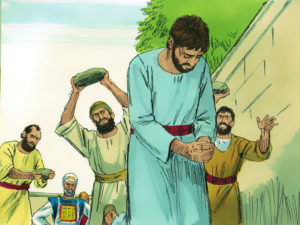 The persecution of Christians grew more dangerous and a mob of people murdered Stephen, one of the early Christian believers. A religious teacher named Saul was one of the people watching the stoning, and he agreed completely with the killing of Stephen. Although he was a Jew, Saul was born and spent his early life in a city called Tarsus, which was a Gentile city far away from Israel and so the people in Tarsus knew him as Paul. But Saul had studied the Old Testament in Jerusalem under a famous teacher. He was very much against Christians.
The persecution of Christians grew more dangerous and a mob of people murdered Stephen, one of the early Christian believers. A religious teacher named Saul was one of the people watching the stoning, and he agreed completely with the killing of Stephen. Although he was a Jew, Saul was born and spent his early life in a city called Tarsus, which was a Gentile city far away from Israel and so the people in Tarsus knew him as Paul. But Saul had studied the Old Testament in Jerusalem under a famous teacher. He was very much against Christians.
Saul the Pharisee, Persecutor
Saul persecuted Christians
 A great wave of persecution began that day, sweeping over the church in Jerusalem; and all the believers except the apostles were scattered through the regions of Judea and Samaria. But the Pharisee Saul was going everywhere to destroy the church. He went from house to house, dragging out both men and women to throw them into prison. Saul received authority from the chief priests and put many of God’s people in prison; and when they were sentenced to death, Saul also voted against them that they would be executed! Many times, Saul had these early Christian men and women arrested and punished and even tried to make them deny their faith. Saul was so furious with them that he even went to foreign cities to persecute them.
A great wave of persecution began that day, sweeping over the church in Jerusalem; and all the believers except the apostles were scattered through the regions of Judea and Samaria. But the Pharisee Saul was going everywhere to destroy the church. He went from house to house, dragging out both men and women to throw them into prison. Saul received authority from the chief priests and put many of God’s people in prison; and when they were sentenced to death, Saul also voted against them that they would be executed! Many times, Saul had these early Christian men and women arrested and punished and even tried to make them deny their faith. Saul was so furious with them that he even went to foreign cities to persecute them.
Saul the Pharisee Persecutor
Christians kept on witnessing to Jesus Christ’s Resurrection
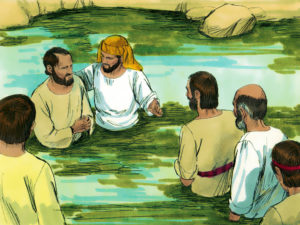 However, Saul could not stop these believers; wherever they went, they told the good news about Jesus Christ’s death and resurrection. Some of the Christians who had been forced out of Jerusalem, came to a nearby region called Samaria. Samaritans, the people who lived there, already believed the first 5 books of the Old Testament and they were excited to hear the message about Jesus Christ’s death and resurrection. So, when the believers from Jerusalem preached to the Samaritans about Jesus, many Samaritans also became believers and God the Holy Spirit enabled them to speak in many foreign languages, just like in Jerusalem 10 days after Jesus went up into heaven.
However, Saul could not stop these believers; wherever they went, they told the good news about Jesus Christ’s death and resurrection. Some of the Christians who had been forced out of Jerusalem, came to a nearby region called Samaria. Samaritans, the people who lived there, already believed the first 5 books of the Old Testament and they were excited to hear the message about Jesus Christ’s death and resurrection. So, when the believers from Jerusalem preached to the Samaritans about Jesus, many Samaritans also became believers and God the Holy Spirit enabled them to speak in many foreign languages, just like in Jerusalem 10 days after Jesus went up into heaven.
A few years after the resurrection, Saul Met Jesus and Became a Christian
Saul Met Jesus Christ
Saul Met Jesus Christ
Jesus Appeared to Saul the Persecutor
 Meanwhile, Saul was uttering threats with every breath and was eager to kill the Lord’s followers. So, he went to the high priest in Jerusalem. He requested letters addressed to the Jewish meeting places in Damascus (a 7-day journey from Jerusalem), asking for their cooperation in the arrest of any followers of Christ he might find there. He wanted to bring them—both men and women—back to Jerusalem in chains. As he was approaching Damascus on this mission, a light from heaven suddenly shone down around him. He fell to the ground and heard a voice saying to him, “Saul! Saul! Why are you persecuting me?” “Who are you, lord?” Saul asked. And the voice replied, “I am Jesus, the one you are persecuting! Now get up and go into the city, and you will be told what you must do.” Saul obeyed Jesus and stayed at someone’s home for several days, praying and fasting.
Meanwhile, Saul was uttering threats with every breath and was eager to kill the Lord’s followers. So, he went to the high priest in Jerusalem. He requested letters addressed to the Jewish meeting places in Damascus (a 7-day journey from Jerusalem), asking for their cooperation in the arrest of any followers of Christ he might find there. He wanted to bring them—both men and women—back to Jerusalem in chains. As he was approaching Damascus on this mission, a light from heaven suddenly shone down around him. He fell to the ground and heard a voice saying to him, “Saul! Saul! Why are you persecuting me?” “Who are you, lord?” Saul asked. And the voice replied, “I am Jesus, the one you are persecuting! Now get up and go into the city, and you will be told what you must do.” Saul obeyed Jesus and stayed at someone’s home for several days, praying and fasting.
Saul Met Jesus Christ
Saul began preaching that Jesus is the Son of God
 God sent a believer to Saul who preached to him the Good News about Jesus Christ. Saul believed the message and was baptized. Saul stayed with the believers in Damascus for a few days. And immediately he began preaching about Jesus in the Jewish meeting places, saying, “He is indeed the Son of God!” All who heard him were amazed. “Isn’t this the same man who caused such suffering by persecuting Jesus’ followers in Jerusalem?” they asked. “And didn’t he come here to arrest them and take them in chains to the leading priests?”
God sent a believer to Saul who preached to him the Good News about Jesus Christ. Saul believed the message and was baptized. Saul stayed with the believers in Damascus for a few days. And immediately he began preaching about Jesus in the Jewish meeting places, saying, “He is indeed the Son of God!” All who heard him were amazed. “Isn’t this the same man who caused such suffering by persecuting Jesus’ followers in Jerusalem?” they asked. “And didn’t he come here to arrest them and take them in chains to the leading priests?”
Saul Met Jesus Christ
Saul studied the Old Testament for 3 years
 Saul went to Arabia for 3 years, where he studied the Old Testament scriptures and saw how many Old Testament prophecies predicted the coming of Jesus Christ. He returned to Damascus and his preaching became more and more powerful, and the Jews in Damascus couldn’t refute his proofs that Jesus was indeed the Messiah.
Saul went to Arabia for 3 years, where he studied the Old Testament scriptures and saw how many Old Testament prophecies predicted the coming of Jesus Christ. He returned to Damascus and his preaching became more and more powerful, and the Jews in Damascus couldn’t refute his proofs that Jesus was indeed the Messiah.
Saul Met Jesus Christ
After he met with Peter & James, Saul went to Tarsus
 Then Saul went to Jerusalem and stayed with the Peter and James and went all around Jerusalem with them, preaching boldly in the name of the Lord. He debated with some Greek-speaking Jews, but they tried to murder him. When the believers heard about this, they took him down to a town on the sea and sent him away on a ship to Tarsus, his hometown, which was far away from Jerusalem. Saul stayed in Tarsus for 8 years.
Then Saul went to Jerusalem and stayed with the Peter and James and went all around Jerusalem with them, preaching boldly in the name of the Lord. He debated with some Greek-speaking Jews, but they tried to murder him. When the believers heard about this, they took him down to a town on the sea and sent him away on a ship to Tarsus, his hometown, which was far away from Jerusalem. Saul stayed in Tarsus for 8 years.
Around this time, the First Gentiles Believed and Became Christians
1st Gentiles Believed
The Apostle John tells about Gentiles coming to faith
1st Gentiles Believed
Christianity started as a religion for Jews
 Christianity in those earliest days was a completely Jewish religion. Jesus was a Jew and all of the believers were either Jews or Samaritans, who were like Jews. That meant that every Christian man had been circumcised and obeyed the Jewish law. Christians all understood the Old Testament stories and understood Old Testament commandments and teachings.
Christianity in those earliest days was a completely Jewish religion. Jesus was a Jew and all of the believers were either Jews or Samaritans, who were like Jews. That meant that every Christian man had been circumcised and obeyed the Jewish law. Christians all understood the Old Testament stories and understood Old Testament commandments and teachings.
1st Gentiles Believed
Jesus had prepared His leaders during His days on earth
 Who were the leaders of Christianity in those earliest days? Jesus had spent three years training His apostles (especially Peter) to be wise teachers and leaders. Jesus had promised that the Holy Spirit would remind those men of everything Jesus had taught them and would guide them into all truth. Jesus’ brothers, especially his brother James, also became important leaders for the churches, which were all Jewish.
Who were the leaders of Christianity in those earliest days? Jesus had spent three years training His apostles (especially Peter) to be wise teachers and leaders. Jesus had promised that the Holy Spirit would remind those men of everything Jesus had taught them and would guide them into all truth. Jesus’ brothers, especially his brother James, also became important leaders for the churches, which were all Jewish.
1st Gentiles Believed
God’s was for all the peoples and not just Jews
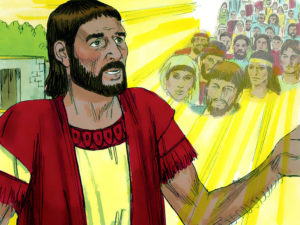
Since the earliest days of God’s Great Salvation Story, God had promised that all of the families of the earth—not just the Jews—would believe the Good News about Jesus Christ’s death and resurrection. The English word for anyone who is not a Jew is “Gentile”. And just like God used Peter to begin preaching the gospel in Jerusalem, God used Peter to bring the gospel to the Gentiles, people who were not Jews. In order for Gentiles to become Christians, 2 different miracles had to happen. First, Gentiles needed to hear the Good News about Jesus Christ’s death and resurrection. But second, Jewish Christians had to believe that Gentiles could become Christians without first becoming Jews. This was something no Jew had ever thought or believed.
1st Gentiles Believed
God spoke to a Gentile named Cornelius to send for Simon Peter
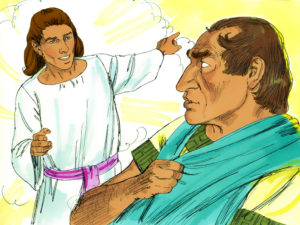 So, God did a double-miracle, giving visions to two different men. First, God gave a vision to a Roman army officer named Cornelius. For many years, Cornelius had believed in the God of the Bible, but he had never converted to become a Jew. In the vision God gave him, Cornelius saw an angel of God coming toward him. “Cornelius!” the angel said. “Send some men to a certain town and tell them to ask a man named Simon Peter to come to you.” Cornelius sent the men just as the vision commanded.
So, God did a double-miracle, giving visions to two different men. First, God gave a vision to a Roman army officer named Cornelius. For many years, Cornelius had believed in the God of the Bible, but he had never converted to become a Jew. In the vision God gave him, Cornelius saw an angel of God coming toward him. “Cornelius!” the angel said. “Send some men to a certain town and tell them to ask a man named Simon Peter to come to you.” Cornelius sent the men just as the vision commanded.
1st Gentiles Believed
God revealed to Simon Peter that He had cleansed all unclean things
 Second, when those men were almost at the house where Simon Peter was staying, God gave Simon Peter a vision and told him to eat animals like pigs and camels. “No, Lord,” Simon Peter said. “I have never eaten anything that our Jewish laws have declared impure and unclean.” But the voice spoke again: “Do not call something unclean if God has made it clean.” The same vision was repeated three times, meaning it was very important. God told him that men were coming and that he should go with them.
Second, when those men were almost at the house where Simon Peter was staying, God gave Simon Peter a vision and told him to eat animals like pigs and camels. “No, Lord,” Simon Peter said. “I have never eaten anything that our Jewish laws have declared impure and unclean.” But the voice spoke again: “Do not call something unclean if God has made it clean.” The same vision was repeated three times, meaning it was very important. God told him that men were coming and that he should go with them.
1st Gentiles Believed
The first Gentiles believed the gospel
 The men arrived at that house and Peter traveled with them back to where Cornelius was waiting. When Peter preached to Cornelius and his family the Good News about Jesus Christ’s death and resurrection, they believed. God chose to show that these new believers were now a part of God’s family; the Holy Spirit enabled them to begin speaking in foreign languages and praising God, just as had happened at Pentecost to the first converts. When Peter saw them miraculously speaking in foreign languages, he realized that God had given His Holy Spirit to Cornelius and his family and therefore they were children of God. Peter did not even suggest that Cornelius and his family had to become Jews first, but baptized them. These were the first Gentiles to become Christians.
The men arrived at that house and Peter traveled with them back to where Cornelius was waiting. When Peter preached to Cornelius and his family the Good News about Jesus Christ’s death and resurrection, they believed. God chose to show that these new believers were now a part of God’s family; the Holy Spirit enabled them to begin speaking in foreign languages and praising God, just as had happened at Pentecost to the first converts. When Peter saw them miraculously speaking in foreign languages, he realized that God had given His Holy Spirit to Cornelius and his family and therefore they were children of God. Peter did not even suggest that Cornelius and his family had to become Jews first, but baptized them. These were the first Gentiles to become Christians.
After that persecution, Many Gentiles in Antioch Become Christians
Antioch-Many Gentiles Convert
The Apostle John tells about how many Gentiles came to follow Jesus in Antioch
Antioch: Many Gentiles Convert
In Antioch, many Gentiles believe in Jesus
 Meanwhile, the believers who had been scattered during the persecution after Stephen’s death traveled to other nearby countries. They preached the Good News about Jesus Christ, but only to Jews. However, some of the believers who went to a city named Antioch (a 14-day journey from Jerusalem) began preaching to the Gentiles about the Lord Jesus. The power of the Lord was with them, and a large number of these Gentiles believed and turned to the Lord. Antioch became a place with many Gentile Christians and the church in Antioch became a center for preaching the Good News for many, many years.
Meanwhile, the believers who had been scattered during the persecution after Stephen’s death traveled to other nearby countries. They preached the Good News about Jesus Christ, but only to Jews. However, some of the believers who went to a city named Antioch (a 14-day journey from Jerusalem) began preaching to the Gentiles about the Lord Jesus. The power of the Lord was with them, and a large number of these Gentiles believed and turned to the Lord. Antioch became a place with many Gentile Christians and the church in Antioch became a center for preaching the Good News for many, many years.
Antioch: Many Gentiles Convert
Barnabas and Saul teach Christians in Antioch
 When the church at Jerusalem heard what was happening in Antioch, they sent a Christian named Barnabas to the church there. When he arrived and saw this evidence of God’s blessing, he was filled with joy, and he encouraged the believers to stay true to the Lord. Barnabas was a good man, full of the Holy Spirit and strong in faith. And many people were brought to the Lord. Then Barnabas went on to Tarsus to look for Saul. When he found him, he brought him back to Antioch. Both of them stayed there with the church for a full year, teaching large crowds of people. (It was at Antioch that the believers were first called Christians.)
When the church at Jerusalem heard what was happening in Antioch, they sent a Christian named Barnabas to the church there. When he arrived and saw this evidence of God’s blessing, he was filled with joy, and he encouraged the believers to stay true to the Lord. Barnabas was a good man, full of the Holy Spirit and strong in faith. And many people were brought to the Lord. Then Barnabas went on to Tarsus to look for Saul. When he found him, he brought him back to Antioch. Both of them stayed there with the church for a full year, teaching large crowds of people. (It was at Antioch that the believers were first called Christians.)
The Gospel of Matthew
The Gospel of Matthew

Matthew (also known as Levi) was originally a Jewish tax collector. In the days of Jesus’ life on earth, tax collectors cheated their fellow Jews, overcharging them entirely unfairly. Therefore, the Jewish people during Jesus’ day hated all tax collectors. Yet Jesus called Matthew to follow Him and to be one of His 12 apostles!
The earliest Christian writers said that Matthew wrote his gospel first. It is very possible that Matthew wrote 10-12 years after Jesus rose from the dead. That means that Matthew’s gospel is very Jewish, because there were few if any Gentile Christians in the church at this point. Matthew’s gospel seems to focus on Jesus Christ as the King, bringing the Kingdom of God to Israel and then to the world.
The first readers of Matthew’s gospels were almost all Jews, many living in Palestine, where Jerusalem and Nazareth are. Matthew seems to have written his gospel for Christians to understand Jesus Christ, His Kingdom teachings, His mission, His life, and His death and resurrection. Surely also, however, Matthew also wrote his gospel for unbelieving Jews to come face-to-face with Jesus Christ.
 Who wrote it? Matthew (also known as Levi), one of Jesus 12 apostles.
Who wrote it? Matthew (also known as Levi), one of Jesus 12 apostles.- Where does it fit in God’s Great Salvation Story? During the Early years when Christianity was almost completely Jewish: After Paul’s conversion, before Paul’s First Missionary Journey
- Who were the original readers? Almost entirely Jewish readers, either Jewish Christians or Jewish unbelievers. It is most likely that there were few Gentile believers in the church at this point of time.
- What was the situation that led Matthew to write? Matthew was presenting to 2 groups of people (Jewish believers and Jewish unbelievers). The early Church needed a collection of what all the apostles had been preaching so that these stories could be learned by believers and passed on to others. Also, Matthew wanted unbelieving Jews to come face to face with the life and teachings and death and resurrection of Jesus Christ as the promised King of the Jews.
- What did Matthew want his letter to change in his readers? Matthew wanted his Christian readers to understand the call of the gospel and what it meant to follow Jesus Christ and proclaim His kingdom. He wanted non-Christian Jews to believe in Jesus as the Son of God and Messiah King and to follow Him.
The Letter Written by James
During those years, The Letter Written by James
The Apostle John tells us about Jesus’ brother James
The Letter Written by James
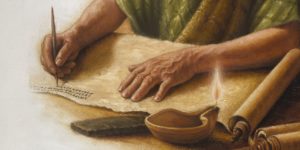 It is probably during these early days that James, the half-brother of Jesus, wrote his famous letter. “This letter is from James, a slave of God and of the Lord Jesus Christ. I am writing to the ‘twelve tribes’—Jewish believers who are scattered abroad. Greetings!” James wrote this to Jewish believers because when he wrote it, with a few exceptions, almost every believer in Jesus Christ was Jewish. There were Cornelius and his family, the Gentile believers in Antioch, but almost everywhere else, Christianity was a Jewish religion.
It is probably during these early days that James, the half-brother of Jesus, wrote his famous letter. “This letter is from James, a slave of God and of the Lord Jesus Christ. I am writing to the ‘twelve tribes’—Jewish believers who are scattered abroad. Greetings!” James wrote this to Jewish believers because when he wrote it, with a few exceptions, almost every believer in Jesus Christ was Jewish. There were Cornelius and his family, the Gentile believers in Antioch, but almost everywhere else, Christianity was a Jewish religion.
The Jewish believers who read James letter were mostly poor, persecuted people who led difficult lives. In these early days of Christianity, these Jewish believers had a habit of loving money and showing special honor to those who were wealthy and powerful. James called this attitude “friendship with the world.” James wanted his readers to be loyal to God’s Word and to follow wisdom from above.
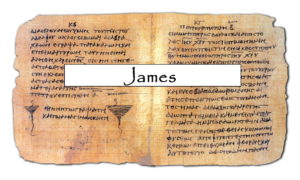 Who wrote it? James the Brother of Jesus
Who wrote it? James the Brother of Jesus- Where does it fit in God’s Great Salvation Story? During the Early years when Christianity was almost completely Jewish: After Paul’s conversion, before Paul’s First Missionary Journey
- Who were the original readers? Mostly poor Jewish Christian Believers who had left Jerusalem, when there were just a few Gentile believers
- What was the situation that led James to write? Christian believers were mostly poor and persecuted and yet they valued money and honor. James called this attitude “friendship with the world.”
- What did James want his letter to change in his readers? He wanted them to be loyal to God and to love everyone equally and fairly and not love money.
Paul’s FIRST Missionary Journey
Paul’s 1st Missionary Journey
The Apostle John tells us about Paul’s 1st Missionary Journey
Stage: Paul’s FIRST Missionary Journey
Saul uses his Tarsus name—Paul
 The Holy Spirit revealed to the church in Antioch to send Barnabas and Saul as the first missionaries, bringing the gospel to people living in other countries. Now that Saul was ministering in a Gentile world, he did not give people his Jewish name, but his Tarsus name—Paul. So, Saul the Pharisee persecutor now introduced himself as Paul the missionary for Jesus Christ.
The Holy Spirit revealed to the church in Antioch to send Barnabas and Saul as the first missionaries, bringing the gospel to people living in other countries. Now that Saul was ministering in a Gentile world, he did not give people his Jewish name, but his Tarsus name—Paul. So, Saul the Pharisee persecutor now introduced himself as Paul the missionary for Jesus Christ.
Stage: Paul’s FIRST Missionary Journey
Paul and Barnabas began their missionary journey
 This first missionary journey took at least a year and possibly as long as a year and a half. Paul and Barnabas usually followed a careful plan. They would arrive in a city or town and find a Jewish meeting place, known as a synagogue. If there was no synagogue, usually Jews would gather together on Saturdays near a river. Paul and Barnabas would share the Good News about Jesus Christ with these Jews, hoping to see some come to faith. If the Jews rejected their preaching in that town, Paul and Barnabas then preached the gospel to the Gentiles. As it turned out, many Gentiles came to faith through their preaching. So whatever Jews and Gentiles in that village, city or town believed became the church.
This first missionary journey took at least a year and possibly as long as a year and a half. Paul and Barnabas usually followed a careful plan. They would arrive in a city or town and find a Jewish meeting place, known as a synagogue. If there was no synagogue, usually Jews would gather together on Saturdays near a river. Paul and Barnabas would share the Good News about Jesus Christ with these Jews, hoping to see some come to faith. If the Jews rejected their preaching in that town, Paul and Barnabas then preached the gospel to the Gentiles. As it turned out, many Gentiles came to faith through their preaching. So whatever Jews and Gentiles in that village, city or town believed became the church.
Stage: Paul’s FIRST Missionary Journey
Many times, people persecuted Paul and Barnabas
![]() It was a difficult and dangerous year of ministry. In almost every village and city, sooner or later someone would lead the people to persecute the two missionaries. Once Paul was even stoned and his missionary career would have ended if God had not miraculously raised him back up, sending him back into the city to preach again.
It was a difficult and dangerous year of ministry. In almost every village and city, sooner or later someone would lead the people to persecute the two missionaries. Once Paul was even stoned and his missionary career would have ended if God had not miraculously raised him back up, sending him back into the city to preach again.
Stage: Paul’s FIRST Missionary Journey
Many Jews fought against Paul & Barnabas’ teaching
![]() Often it was Jews who stirred the people to attack. Why were the Jews so opposed to Paul and Barnabas? Many Jews believed Jesus was a false Messiah and many rejected Jesus’ claim to be God’s unique Son. But the real reason might have been how Jews felt about Gentiles who were now Christians. You see, Paul and Barnabas did not force Gentile believers to become Jews. Instead, Paul and Barnabas taught them that they were saved by faith in Jesus and that salvation was a gift of grace from God.
Often it was Jews who stirred the people to attack. Why were the Jews so opposed to Paul and Barnabas? Many Jews believed Jesus was a false Messiah and many rejected Jesus’ claim to be God’s unique Son. But the real reason might have been how Jews felt about Gentiles who were now Christians. You see, Paul and Barnabas did not force Gentile believers to become Jews. Instead, Paul and Barnabas taught them that they were saved by faith in Jesus and that salvation was a gift of grace from God.
Stage: Paul’s FIRST Missionary Journey
Paul and Barnabas revisited Christians & then returned home
![]() The last part of the journey focused on revisiting wherever they had gone originally, strengthening the believers and encouraging them to keep growing and learning. When they finally returned to Antioch, the Christians there were thrilled to hear of the many people who had believed the Good News. And… most of those new Christians were not Jews but Gentiles. A change was coming to Christianity.
The last part of the journey focused on revisiting wherever they had gone originally, strengthening the believers and encouraging them to keep growing and learning. When they finally returned to Antioch, the Christians there were thrilled to hear of the many people who had believed the Good News. And… most of those new Christians were not Jews but Gentiles. A change was coming to Christianity.
When Pau’s 1st journey was over, the Challenge: how to Deal with Gentile Believers
The Challenge of Gentile Christians
The Apostle John talks about the Challenge of what to do about Gentile believers
Stage: How to Deal with Gentile Believers
Peter & other Jewish Christians dishonored Gentile Christians
![]() During these days, while Paul was back in Antioch, Simon Peter came there and began ministering and teaching the people, side-by-side with Paul. When he first arrived, Peter ate with the Gentile believers, who were not circumcised. But afterward, when some friends of James, Jesus’ brother, came, Peter wouldn’t eat with Gentiles anymore. He was afraid of criticism from these people who insisted that Gentiles must become Jews by being circumcised. As a result, other Jewish believers followed Peter’s hypocrisy, and even Barnabas was led astray by their hypocrisy.
During these days, while Paul was back in Antioch, Simon Peter came there and began ministering and teaching the people, side-by-side with Paul. When he first arrived, Peter ate with the Gentile believers, who were not circumcised. But afterward, when some friends of James, Jesus’ brother, came, Peter wouldn’t eat with Gentiles anymore. He was afraid of criticism from these people who insisted that Gentiles must become Jews by being circumcised. As a result, other Jewish believers followed Peter’s hypocrisy, and even Barnabas was led astray by their hypocrisy.
Stage: How to Deal with Gentile Believers
Paul spoke harshly to Peter in front of Church
![]() Paul, however, realized that his good friends Peter and Barnabas were not following the truth of the gospel message. He spoke to Peter right in front of all the others, “Since you, a Jew by birth, have discarded the Jewish laws and are living like a Gentile, why are you now trying to make these Gentiles follow the Jewish traditions? For no one will ever be made right with God by obeying the law. For if keeping the law could make us right with God, then there was no need for Christ to die.”
Paul, however, realized that his good friends Peter and Barnabas were not following the truth of the gospel message. He spoke to Peter right in front of all the others, “Since you, a Jew by birth, have discarded the Jewish laws and are living like a Gentile, why are you now trying to make these Gentiles follow the Jewish traditions? For no one will ever be made right with God by obeying the law. For if keeping the law could make us right with God, then there was no need for Christ to die.”
Stage: How to Deal with Gentile Believers
Jewish Christians pressurized Gentile Christians to become Jews first
 While Paul and Barnabas were in Antioch, other Christian missionaries decided to visit the Christians Paul and Barnabas had evangelized in the state of Galatia. These missionaries were Jewish Christians, which makes sense, since at this early point most Christians were Jewish. However, these men strongly disagreed with Paul about God’s grace. They believed that a Gentile could not find eternal salvation without first becoming a Jew. They commanded these Gentile Christians to submit themselves to the ritual of circumcision. This subject of circumcision was really a big issue; some non-Christian Jews had persecuted Paul and Barnabas because they had not forced Gentile Christians to convert to Judaism first, i.e., to be circumcised. So, when these Jewish Christian teachers commanded the Galatian Gentile Christians to convert to Judaism, the poor Gentiles did not know what to do.
While Paul and Barnabas were in Antioch, other Christian missionaries decided to visit the Christians Paul and Barnabas had evangelized in the state of Galatia. These missionaries were Jewish Christians, which makes sense, since at this early point most Christians were Jewish. However, these men strongly disagreed with Paul about God’s grace. They believed that a Gentile could not find eternal salvation without first becoming a Jew. They commanded these Gentile Christians to submit themselves to the ritual of circumcision. This subject of circumcision was really a big issue; some non-Christian Jews had persecuted Paul and Barnabas because they had not forced Gentile Christians to convert to Judaism first, i.e., to be circumcised. So, when these Jewish Christian teachers commanded the Galatian Gentile Christians to convert to Judaism, the poor Gentiles did not know what to do.
Paul’s Letter to the Galatians
Paul’s letter to the Galatians
The Apostle John talks about the problem which led Paul to write Galatians
Paul’s Letter to the Galatians
Paul wrote a letter to the Galatians to help early believers understand grace
 After Paul and Barnabas came back to the city of Antioch from their first missionary journal, they began hearing news that a problem was happening. Churches in the province of Galatia were being influenced by Jewish Christians, think now that they needed to become Jews in order to be saved. That led Paul to write his first letter, Galatians. The book of Galatians was written to these new Gentile converts who were being incorrectly taught that they must be circumcised to be saved. Paul wanted these early believers to understand that Christ and Christ alone saves us, not circumcision or any other ritual.
After Paul and Barnabas came back to the city of Antioch from their first missionary journal, they began hearing news that a problem was happening. Churches in the province of Galatia were being influenced by Jewish Christians, think now that they needed to become Jews in order to be saved. That led Paul to write his first letter, Galatians. The book of Galatians was written to these new Gentile converts who were being incorrectly taught that they must be circumcised to be saved. Paul wanted these early believers to understand that Christ and Christ alone saves us, not circumcision or any other ritual.

- Who wrote it? Paul
- Where does it fit in God’s Great Salvation Story? This was in the early days of the church, fewer than 20 years after Jesus rose from the dead. It was right after the first missionary journey of Paul and Barnabas, but before the important Council of Jerusalem (Acts 15).
- Who were the original readers? Brand new believers who were Gentile Christians living in the province of Galatia (it was not a city but a province). They had only been Christians for a few months.
- What was the situation that led Paul to write? Jewish Christians were trying to change the gospel into a different gospel, even though Paul warns them there is only one gospel (when you think of the word “gospel”, think of it as “the message of Good News”). What were these Jewish Christians doing? They were trying to convince Gentile Christians that people can only be righteous before God if they FIRST become Jews (through circumcision). This was not the true gospel at all, for the cross of Jesus Christ was the only way to become righteous. No one could be saved apart from Christ’s cross, and no one who truly embraced God’s grace through Christ’s cross could be considered unsaved.
- What did Paul want his letter to change in his readers? He wanted them to trust that righteousness comes only through faith in Jesus Christ.
To bring an answer, the Council of Jerusalem affirms Salvation by Grace
The Council of Jerusalem
John Explains how the Council of Jerusalem happened
The Council of Jerusalem
Jewish Christians tried to pressurize Gentile Christians in Antioch
 About this same time, while Paul and Barnabas were at Antioch, some men from Judea arrived and began to teach wrong teachings to the Gentile believers in Antioch: “Unless you are circumcised as required by the law of Moses, you cannot be saved.” Paul and Barnabas strongly disagreed with them. Finally, after much strong debate, the church decided to send Paul and Barnabas to Jerusalem, accompanied by some local believers, to talk to the apostles and elders about this question. This meeting in Jerusalem became one of the most important events in the history of Christianity—answering the question of whether Gentiles needed to become Jews in order to receive God’s eternal salvation. The meeting is known as the Council of Jerusalem.
About this same time, while Paul and Barnabas were at Antioch, some men from Judea arrived and began to teach wrong teachings to the Gentile believers in Antioch: “Unless you are circumcised as required by the law of Moses, you cannot be saved.” Paul and Barnabas strongly disagreed with them. Finally, after much strong debate, the church decided to send Paul and Barnabas to Jerusalem, accompanied by some local believers, to talk to the apostles and elders about this question. This meeting in Jerusalem became one of the most important events in the history of Christianity—answering the question of whether Gentiles needed to become Jews in order to receive God’s eternal salvation. The meeting is known as the Council of Jerusalem.
The Council of Jerusalem
When the Council happened, most Christians were Jewish
 Most of the Christians in the world at that time were Jewish. Jesus had trained His apostles in the Gospel and because of that they were convinced that salvation did not come through adding the Law to Christ’s cross, but through grace alone. God’s plan was always all about grace which was available to all who confessed to God their sinfulness and turned to Jesus Christ for eternal salvation from sin.
Most of the Christians in the world at that time were Jewish. Jesus had trained His apostles in the Gospel and because of that they were convinced that salvation did not come through adding the Law to Christ’s cross, but through grace alone. God’s plan was always all about grace which was available to all who confessed to God their sinfulness and turned to Jesus Christ for eternal salvation from sin.
The Council of Jerusalem
James suggested Gentiles should not be forced to become Jews
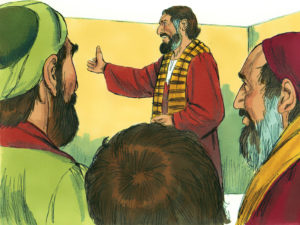 The meeting had lots of discussion for and against salvation by grace alone. After much debate, Jesus’ brother James (the one who wrote the Book of James that we’ve already talked about) said, “My judgment is that we should not make it difficult for the Gentiles who are turning to God. Instead, we should write and tell them to abstain from eating food offered to idols, from sexual immorality, from killing babies (either unborn or newly born) and from committing murder. For these laws of Moses have been preached in Jewish synagogues in every city on every Sabbath for many generations.”
The meeting had lots of discussion for and against salvation by grace alone. After much debate, Jesus’ brother James (the one who wrote the Book of James that we’ve already talked about) said, “My judgment is that we should not make it difficult for the Gentiles who are turning to God. Instead, we should write and tell them to abstain from eating food offered to idols, from sexual immorality, from killing babies (either unborn or newly born) and from committing murder. For these laws of Moses have been preached in Jewish synagogues in every city on every Sabbath for many generations.”
The Council of Jerusalem
The Council sent a letter promoting grace
 The entire group agreed. They wrote a letter saying this and set aside 2 men to bring that letter to the church in Antioch. The messengers went at once to Antioch, where they called a general meeting of the believers and delivered the letter. And there was great joy throughout the church that day as they read this encouraging message.
The entire group agreed. They wrote a letter saying this and set aside 2 men to bring that letter to the church in Antioch. The messengers went at once to Antioch, where they called a general meeting of the believers and delivered the letter. And there was great joy throughout the church that day as they read this encouraging message.
After the Council, Paul’s Second Missionary Journey to Macedonia
Pauls 2nd Missionary Journey
The Apostle John tells about Paul’s 2nd Missionary Journey
Pauls 2nd Missionary Journey
Paul and Silas visit previously converted Christians
 After all of this, Paul decided to return to where he had first preached the Good News, to encourage the people who had believed in Jesus during his missionary journey. This time a believer name Silas and a young man named Timothy joined him in the ministry. Everywhere they went, they read the letter from the leaders in Jerusalem and encouraged Christian believers. After going through many different places, finally, they arrived in a city on the sea.
After all of this, Paul decided to return to where he had first preached the Good News, to encourage the people who had believed in Jesus during his missionary journey. This time a believer name Silas and a young man named Timothy joined him in the ministry. Everywhere they went, they read the letter from the leaders in Jerusalem and encouraged Christian believers. After going through many different places, finally, they arrived in a city on the sea.
Pauls 2nd Missionary Journey
Paul’s received a vision to evangelize the province of Macedonia
 At night Paul had a vision: A man from Macedonia in northern Greece was standing there, pleading with him, “Come over to Macedonia and help us!” So, Paul, Silas, Timothy,
At night Paul had a vision: A man from Macedonia in northern Greece was standing there, pleading with him, “Come over to Macedonia and help us!” So, Paul, Silas, Timothy,
Another believer named Luke (who was a doctor) decided to leave for Macedonia at once, having concluded that God was calling them to preach the Good News there.
Pauls 2nd Missionary Journey
Paul leads people in Philippi to faith in Jesus
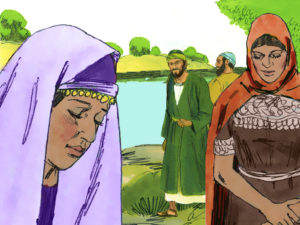 The first city they visited was Philippi. On Saturday, Paul and his co-workers found a small group of Jews meeting for prayer by a river outside the city. They began sharing the Good News about Jesus Christ with these Jews and one of them, a woman named Lydia, believed. Her entire household believed, and others believed as well. After that, Paul and his co-workers often went to this place of prayer to meet with those who had received the Good News.
The first city they visited was Philippi. On Saturday, Paul and his co-workers found a small group of Jews meeting for prayer by a river outside the city. They began sharing the Good News about Jesus Christ with these Jews and one of them, a woman named Lydia, believed. Her entire household believed, and others believed as well. After that, Paul and his co-workers often went to this place of prayer to meet with those who had received the Good News.
Pauls 2nd Missionary Journey
Paul and Silas led their jailor and his family to faith in Jesus Christ
 Paul’s ministry in Philippi angered some idol worshiping people and a mob formed against them and the city officials ordered them stripped and beaten with wooden rods. They were severely beaten, and then they were thrown into prison. The jailer was ordered to make sure they didn’t escape. So, the jailer put them into the inner dungeon and clamped their feet in the stocks.
Paul’s ministry in Philippi angered some idol worshiping people and a mob formed against them and the city officials ordered them stripped and beaten with wooden rods. They were severely beaten, and then they were thrown into prison. The jailer was ordered to make sure they didn’t escape. So, the jailer put them into the inner dungeon and clamped their feet in the stocks.
 Through an earthquake, Paul and Silas were set free but they did not try to escape.
Through an earthquake, Paul and Silas were set free but they did not try to escape.
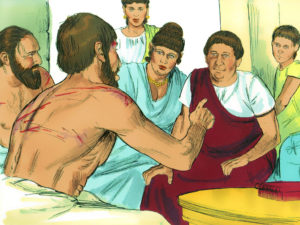 Paul shared the gospel with the jailer and the man and his family believed the good news.
Paul shared the gospel with the jailer and the man and his family believed the good news.
 Then he and everyone in his household were immediately baptized. These early believers, such as the jailor’s and Lydia’s families, became the church of Philippi. Later on, Paul wrote a famous letter, Philippians, to these very people.
Then he and everyone in his household were immediately baptized. These early believers, such as the jailor’s and Lydia’s families, became the church of Philippi. Later on, Paul wrote a famous letter, Philippians, to these very people.
Pauls 2nd Missionary Journey
Paul and Silas ministered in Thessalonica
 Paul and Silas then traveled to Thessalonica, where there was a Jewish synagogue. As was Paul’s custom, he went to the synagogue service, and for three Saturdays in a row he used the Scriptures to prove that Jesus was the Messiah and to show that the Old Testament Scriptures predicted that the Messiah must suffer and rise from the dead. Some of the Jews who listened were persuaded and joined Paul and Silas, along with many Gentiles who already believed the Old Testament. These people became the church of the Thessalonians. Paul probably continued to teach them for some time, although we cannot be sure how long.
Paul and Silas then traveled to Thessalonica, where there was a Jewish synagogue. As was Paul’s custom, he went to the synagogue service, and for three Saturdays in a row he used the Scriptures to prove that Jesus was the Messiah and to show that the Old Testament Scriptures predicted that the Messiah must suffer and rise from the dead. Some of the Jews who listened were persuaded and joined Paul and Silas, along with many Gentiles who already believed the Old Testament. These people became the church of the Thessalonians. Paul probably continued to teach them for some time, although we cannot be sure how long.
Pauls 2nd Missionary Journey
Persecution forced Paul and Silas to leave Thessalonica and then another town
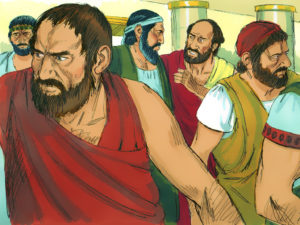 But some of the unbelieving Jews were jealous, so they gathered some troublemakers from the marketplace to form a mob and start a riot. That very night the believers sent Paul and Silas to a different town. When Paul and Silas arrived there, they went to the Jewish synagogue. As a result of Paul’s preaching, many Jews believed, as did many of the prominent Gentile women and men. But when some Jews in Thessalonica learned that Paul was preaching the word of God in that town, the Jews went there and stirred up trouble. So, Paul left Macedonia to go to Greece, to a city called Corinth.
But some of the unbelieving Jews were jealous, so they gathered some troublemakers from the marketplace to form a mob and start a riot. That very night the believers sent Paul and Silas to a different town. When Paul and Silas arrived there, they went to the Jewish synagogue. As a result of Paul’s preaching, many Jews believed, as did many of the prominent Gentile women and men. But when some Jews in Thessalonica learned that Paul was preaching the word of God in that town, the Jews went there and stirred up trouble. So, Paul left Macedonia to go to Greece, to a city called Corinth.
During the 2nd Missionary Journey, Paul spent 18 months in Corinth
The Apostle John talks about Paul’s time in Corinth
Pauls 18 Months in Corinth
Paul first preached in the Synagogue, but was opposed
 Paul lived and worked in Corinth for a long time. At first, he stayed with a man named Aquilla and his wife Priscilla, which was a perfect arrangement because they were believers and had the same trade, making tents, which was Paul’s trade as well. Each Sabbath Paul would go to the synagogue, trying to convince the Jews and Gentiles that Jesus was the Messiah. But when the Jews opposed and insulted him, Paul said, “Your blood is upon your own heads—I am innocent. From now on I will go preach to the Gentiles.”
Paul lived and worked in Corinth for a long time. At first, he stayed with a man named Aquilla and his wife Priscilla, which was a perfect arrangement because they were believers and had the same trade, making tents, which was Paul’s trade as well. Each Sabbath Paul would go to the synagogue, trying to convince the Jews and Gentiles that Jesus was the Messiah. But when the Jews opposed and insulted him, Paul said, “Your blood is upon your own heads—I am innocent. From now on I will go preach to the Gentiles.”
Pauls 18 Months in Corinth
Paul led many people in Corinth to faith in Jesus Christ
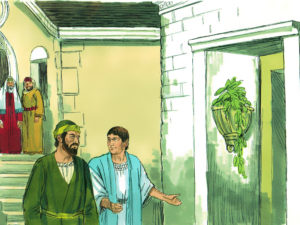 Then he left and went to the home of Titius Justus, a Gentile who worshiped God and lived next door to the synagogue. Crispus, the leader of the synagogue, and everyone in his household believed in the Lord. Many others in Corinth also heard Paul, became believers, and were baptized. One night the Lord spoke to Paul in a vision and told him, “Don’t be afraid! Speak out! Don’t be silent! For I am with you, and no one will attack and harm you, for many people in this city belong to me.” So, Paul stayed there for the next year and a half, teaching the word of God.
Then he left and went to the home of Titius Justus, a Gentile who worshiped God and lived next door to the synagogue. Crispus, the leader of the synagogue, and everyone in his household believed in the Lord. Many others in Corinth also heard Paul, became believers, and were baptized. One night the Lord spoke to Paul in a vision and told him, “Don’t be afraid! Speak out! Don’t be silent! For I am with you, and no one will attack and harm you, for many people in this city belong to me.” So, Paul stayed there for the next year and a half, teaching the word of God.
Pauls 18 Months in Corinth
Paul wrote a letter to encourage the persecuted Christians in Thessalonica
 While he was serving in Corinth, Paul found out that Jews in the city of Thessalonica were still persecuting Christians there. That worried Paul, because they were all new believers and he was afraid they might leave the faith. As time went on, however, good reports came to Paul that the believers had instead grown stronger in their faith. He decided to write a letter to help these new believers to keep on being faithful and to correct some misunderstandings they had. We have a copy of this letter, which is known as 1 Thessalonians.
While he was serving in Corinth, Paul found out that Jews in the city of Thessalonica were still persecuting Christians there. That worried Paul, because they were all new believers and he was afraid they might leave the faith. As time went on, however, good reports came to Paul that the believers had instead grown stronger in their faith. He decided to write a letter to help these new believers to keep on being faithful and to correct some misunderstandings they had. We have a copy of this letter, which is known as 1 Thessalonians.
Paul’s Two Letters to Thessalonica
Paul’s 2 letters to Thessalonica
The Apostle John introduces the 2 letters to Thessalonica
Paul’s First Letter to the Thessalonians
 Apparently, some of the Christian believers in Thessalonica had recently died, which worried other believers. What would happen to these now-dead Christian people when Jesus returned and transformed all believers into glorious new bodies? Was there no hope for them those who already died? Therefore, Paul wrote to assure them that anyone who believed in Jesus, even if they died in this life, would still be raised up in glory when Jesus returned.
Apparently, some of the Christian believers in Thessalonica had recently died, which worried other believers. What would happen to these now-dead Christian people when Jesus returned and transformed all believers into glorious new bodies? Was there no hope for them those who already died? Therefore, Paul wrote to assure them that anyone who believed in Jesus, even if they died in this life, would still be raised up in glory when Jesus returned.
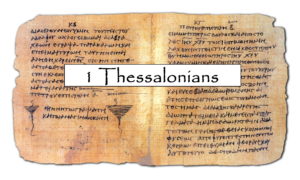
- Who wrote it? Paul
- Where does it fit in God’s Great Salvation Story? During Paul stay in Corinth for 18 months, during Paul’s 2nd missionary journey to Macedonia, before Paul’s third missionary journey to Ephesus
- Who were the original readers? Some Jewish Christians along with many Gentiles who already believed the Old Testament who were being persecuted because of their faith.
- What was the situation that led Paul to write? These were new Christians and they needed some basic reminders about their Christian faith: as they suffered persecution they needed to learn to trust God’s word and Paul’s ministry, to choose to live in obedience to Christ and to trust God that believers who die before Jesus’ return will rise from the grave when Jesus comes back.
- What did Paul want his letter to change in his readers? He wanted them to ready to suffer for Christ and to live holy and pure lives AND to have encouragement that death cannot separate believers from Jesus Christ.
Paul’s Two Letters to the Thessalonians
2 Thessalonians
 Paul ended up writing a second letter to these believers in Thessalonica, because people were still confused about Jesus’ return. Some people were teaching that Jesus had already come back; Paul wanted the believers to understand that certain events had to happen before Jesus returned. Some Christians had quit their jobs so they could be ready for Christ’s return, but Paul told them to get back to work. He also explained the events which had to happen first before Jesus would return. This letter is known as 2 Thessalonians.
Paul ended up writing a second letter to these believers in Thessalonica, because people were still confused about Jesus’ return. Some people were teaching that Jesus had already come back; Paul wanted the believers to understand that certain events had to happen before Jesus returned. Some Christians had quit their jobs so they could be ready for Christ’s return, but Paul told them to get back to work. He also explained the events which had to happen first before Jesus would return. This letter is known as 2 Thessalonians.
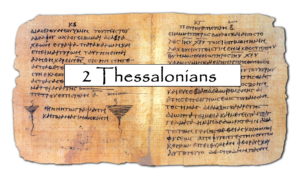
- Who wrote it? Paul
- Where does it fit in God’s Great Salvation Story?
- During Paul’s stay in Corinth for 18 months
- Who were the original readers?
- Some Jewish Christians along with many Gentiles who already believed the Old Testament who were being persecuted because of their faith.
- What was the situation that led Paul to write?
- New Christian believers were still being persecuted and were confused about when Jesus would return; some had quit their jobs because they were so certain that Jesus was coming very soon.
- What did Paul want his letter to change in his readers?
Paul wanted his readers to understand that God was allowing them to be persecuted and that difficult times would be coming before the day of the Lord and they should stand strong as believers and continue to work with their hands.
End of Paul’s 2nd Missionary Journey
Paul leaves Ephesus and returns to Antioch
Soon after, Paul’s Third Missionary Journey to Ephesus
Soon after, Paul’s Third Missionary Journey to Ephesus
The Apostle John talks about Paul’s 2 1/2 years in Ephesus
Paul’s Third Missionary Journey to Ephesus
Paul’s 3rd Missionary Journey to Ephesus
 After spending some time in Antioch, Paul went back through Galatia and other areas he had already been, visiting and strengthening all the believers. Eventually, Paul ended up in Ephesus, one of the greatest cities in the ancient Roman Empire. He went to the synagogue and preached boldly for the next three months, arguing persuasively about the Kingdom of God. But some became stubborn, rejecting his message and publicly speaking against the Way. So, Paul left the synagogue and took the believers with him. Then he held daily discussions at a local lecture hall. This went on for the next two years, so that people throughout the province—both Jews and Gentiles—heard the word of the Lord
After spending some time in Antioch, Paul went back through Galatia and other areas he had already been, visiting and strengthening all the believers. Eventually, Paul ended up in Ephesus, one of the greatest cities in the ancient Roman Empire. He went to the synagogue and preached boldly for the next three months, arguing persuasively about the Kingdom of God. But some became stubborn, rejecting his message and publicly speaking against the Way. So, Paul left the synagogue and took the believers with him. Then he held daily discussions at a local lecture hall. This went on for the next two years, so that people throughout the province—both Jews and Gentiles—heard the word of the Lord
Paul’s 3rd Missionary Journey to Ephesus
The Corinthians wrote Paul about questions and problems in Corinth
 While Paul was in Ephesus, some Christians came to him from Corinth carrying a letter. Remember, Paul had lived with the Corinthians for 18 months and many of the believers in that church had come to faith through Paul’s ministry. The letter asked some pretty important questions about marriage. In addition, they had questions about whether it was sin to eat which had been sacrificed in an idol’s temple or whether woman should cover their heads, about spiritual gifts (especially tongues) and about the resurrection.
While Paul was in Ephesus, some Christians came to him from Corinth carrying a letter. Remember, Paul had lived with the Corinthians for 18 months and many of the believers in that church had come to faith through Paul’s ministry. The letter asked some pretty important questions about marriage. In addition, they had questions about whether it was sin to eat which had been sacrificed in an idol’s temple or whether woman should cover their heads, about spiritual gifts (especially tongues) and about the resurrection.
Paul’s First Letter to the Corinthians
Paul’s 2 Letters to the Corinthians
The Apostle John explains why Paul wrote these 2 letters
Paul’s 2 Letters to the Corinthians
Paul’s First Letter to the Corinthians
 These questions might have seemed innocent enough, but there was something else going on—the church was filled with fighting and factions. Christians were saying that they belonged to Peter or Paul or Apollos (a well-known evangelist) or Jesus Himself. That’s probably where most of the questions came from, arguments about who was right and who was wrong. So, Paul wrote the famous letter 1 Corinthians, answering these serious questions, but even more than that explaining what it means to be the body of Jesus Christ. People often think of the love chapter, 1 Corinthians 13, but don’t realize that Paul wrote this to a church filled with fighting and division
These questions might have seemed innocent enough, but there was something else going on—the church was filled with fighting and factions. Christians were saying that they belonged to Peter or Paul or Apollos (a well-known evangelist) or Jesus Himself. That’s probably where most of the questions came from, arguments about who was right and who was wrong. So, Paul wrote the famous letter 1 Corinthians, answering these serious questions, but even more than that explaining what it means to be the body of Jesus Christ. People often think of the love chapter, 1 Corinthians 13, but don’t realize that Paul wrote this to a church filled with fighting and division
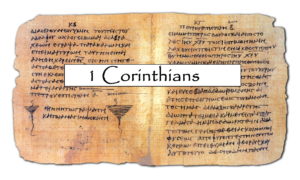
- Who wrote it? Paul
- Where does it fit in God’s Great Salvation Story? During Paul’s third missionary journey in Ephesus after Paul staying in Corinth for 18 Months and before Paul’s return to Corinth for 3 months
- Who were the original readers? Gentile and Jewish Christians who knew Paul well, but were very influenced by their local culture which was corrupt, committed to self-glorification, following rich and powerful people to get favors and promotions, and praising impressive public speakers who were treated like today’s Bollywood stars.
- What was the situation that led Paul to write? The Christians were proud, and each thought he was wise and others were stupid. They were fighting with one another and taking up sides about questions of incest, sexual immorality, lawsuits between believers, marriage, eating food from an idol’s temple, women in the church, spiritual gifts (especially tongues), and confusion about the resurrection.
- What did Paul want his letter to change in his readers? He wanted the Corinthians to learn to live according to Jesus Christ’s cross, humbling themselves and accepting God’s foolishness as the true wisdom, which always leads believers to love and service and never to self-glorification.
Paul’s Letter to the Philippians
Paul’s Letter to Philippi
The Apostle John talks about Paul’s Letter to the Philippians
Paul’s Letter to the Philippians
Paul wrote the letter to the Philippians

During the last month of Paul’s time in Ephesus, he sent for the believers and encouraged them and said good-bye, leaving for Macedonia, where the city of Philippi is. While there, he encouraged the believers in all the towns he passed through. Then he traveled down to Greece, where he stayed for three months. We can’t be sure whether Paul wrote Philippians from Corinth during those months or Ephesus or from Rome later on. He was in prison, but where and when? According to Paul, he had been imprisoned many times and Philippians was written during one of those imprisonments. We are including the letter to the Philippians here in the story because we cannot guess exactly when it was written, but it is probably more likely to be sent from Ephesus or even Corinth and less likely to have been sent from Rome.

- Who wrote it? Paul
- Where does it fit in God’s Great Salvation Story? Perhaps during Paul’s Third Missionary Journey, when He had returned to Corinth for 3 Months, perhaps when Paul had written the book of Romans and possibly before Paul was arrested in Jerusalem.
- Who were the original readers? Christians in Philippi who were serving the Lord wholeheartedly and needed to grow in being ready to suffer in the work of the gospel.
- What was the situation that led Paul to write? There was no bad situation, although 2 Christian women in the fellowship were apparently not speaking to each other. In fact, Paul clearly thinks the Christians in Philippi were doing things exactly right in most ways.
- What did Paul want his letter to change in his readers? The Philippians needed to grow in unity centered on the ministry of the gospel AND they need to go deeper and deeper into Christian joy.
Paul’s Second Letter to the Corinthians
Paul’s Letter to Philippi
The Apostle John talks about Paul’s Second Letter to the Corinthians
Paul’s Two Letters to the Corinthians
Paul’s Second Letter to the Corinthians
 Paul’s letter of 1 Corinthians apparently did not help enough,
Paul’s letter of 1 Corinthians apparently did not help enough,
Paul traveled to Corinth from Ephesus for an unexpected and unpleasant visit.
During that visit, someone in Corinth strongly opposed Paul and some people in the church joined that opponent. Paul left the church without coming to a happy solution. Therefore, Paul wrote a harsh letter to them and had a young man named Titus bring it to the church. We do not have a copy of that letter, but we know that the letter caused them grief. Paul himself wrote that letter in great anguish, with a troubled heart and many tears. He didn’t want to grieve the Corinthians, but he wanted to let them know how much love he had for them and how important it was for them to follow the apostles’ teachings.
 When Titus finally came back to Paul from Corinth, he had some good news; the Corinthians had punished the man causing the troubles and had mostly chosen to support Paul. But Timothy also had bad news; outsiders, men who were calling themselves “super apostles” were telling the congregation that Paul was a second-class apostle and people should not listen to him. This led Paul to write the book of 2 Corinthians.
When Titus finally came back to Paul from Corinth, he had some good news; the Corinthians had punished the man causing the troubles and had mostly chosen to support Paul. But Timothy also had bad news; outsiders, men who were calling themselves “super apostles” were telling the congregation that Paul was a second-class apostle and people should not listen to him. This led Paul to write the book of 2 Corinthians.

- Who wrote it? Paul
- Where does it fit in God’s Great Salvation Story? During Paul’s third missionary to Ephesus, after he had written 1 Corinthians and before he went to Jerusalem.
- Who were the original readers? The Christians were proud of their knowledge, and each thought he was wise and others were stupid. They were being influenced by desire for impressive spiritual gifts and preaching.
- What was the situation that led Paul to write? False apostles who called themselves “super apostles” were influencing the Corinthians to question Paul’s authority because he seemed weak physically, in his preaching and in his social standing. Also, Paul was bringing a mercy gift to Christians in Jerusalem and wanted to make sure the Corinthians were generous to help in this.
- What did Paul want his letter to change in his readers? Paul wanted the Corinthians to learn that God’s way of overcoming the world is through the weakness of the cross of Christ, which should influence everything Christians do and understand. The cross destroys selfishness, self-confidence, self-glorification and bring self-denial, weakness and especially love. He also wanted them to be generous
As the church grew, Gentile Christians Become the Church Leaders
Gentiles Become Church Leaders
The Apostle John describes how Gentiles became the Church leaders in Rome
Gentiles Become Church Leaders
At first, the Roman Church was run by Jewish Christians

On the day of Pentecost, we know that Jews from Rome heard Peter’s first sermon and we can guess that some of those Jews believed in Jesus Christ and brought the message with them when they returned home. Many people in Rome, both Jews and Gentiles, believed this Good News. Probably the Jewish Christians were in the most senior positions in the churches, since they were already experts in the Old Testament and knew far more than Gentile believers could know.
Gentiles Become Church Leaders
The Emperor forced Jews (including Jewish Christians) to leave Rome

However, all of this changed. About 20 years after Jesus’ resurrection, we know from history that the Roman Emperor had forced all Jews to leave Rome, because they had been rioting against Christians. We know that Jewish Christians were also forced to leave the city (Priscilla and her husband Aquilla were forced to leave), when meant that for about 4 or 5 years, the churches in Rome were run by Gentile Christians. We can guess that more and more Gentiles believed the gospel.
Gentiles Become Church Leaders
When Jewish Christians returned, they disagreed with Gentiles church leaders

So… when Jews were allowed back into Rome about 4 or 5 years later, the Jewish Christians discovered they were a minority. AND Gentiles, who regularly ate pork, worked on the Sabbath, and did not follow many of the Old Testament laws, were running the churches. We can guess from reading Romans that the Jewish Christians did not at all like this situation and judged the Gentile Christians as very sinful people! And the Gentile Christians actually looked down on the Jewish Christians because they believed Jewish Christians were immature in their faith, people who did not understand that they were now free of the Law.
Paul’s Letter to the Romans
Paul’s Letter to Rome
The Apostle John thinks about about Paul’s letter to the Romans
Paul’s Letter to the Romans
Paul wrote the letter to the Romans to bring unity between Jews and Gentiles

To bring unity to a divided church, Paul wrote his most famous letter of all, the book of Romans. Since the problem was pride and judging, Paul in his letter explained that everyone on the planet earth was a sinner separated from God and without hope for salvation, so there was nothing to be proud about. He explained to them that God had created a way to bring eternal righteousness apart from obedience to the Law, the righteousness which comes through faith in Jesus Christ. And he showed them that God had given each believer His Holy Spirit, giving them the first experience of the blessings they have received and will someday experience through Jesus Christ. If everyone, whether Jew or a Gentile, came to God the same way (through faith in Jesus Christ), then Jews and Gentiles should have started treating each as equals. No one had any right to judge or to look down on others, because everything they had as Christians was through the grace of God in Christ
CLICK HERE FOR AN OUTLINE TO THE BOOK OF ROMANS
- Who wrote it? Paul
- Where does it fit in God’s Great Salvation Story? As Gentile Christians are becoming the Church leaders, during Paul’s 3-month stay in Corinth, after Paul’s 2 ½ years in Ephesus during his 3rd Missionary Journey, before Paul prepares to go to Jerusalem.
- Who were the original readers? Jewish and Gentile Christians, some of whom had been Christians for over 20 years.
- What was the situation that led Paul to write? The Jewish Christians were unhappy with the way Gentile Christians were ignoring Old Testament Laws about obeying the Sabbath and clean and unclean and the Gentile Christians saw the Jewish Christians as weak in their faith because of this.
- What did Paul want his letter to change in his readers? He wanted all Christians, Jewish or Gentile, to walk in unity because they understood that their righteousness came solely through Christ’s cross, received by faith and experienced through the transforming work of the Holy Spirit.
Paul’s Third Missionary Journey’s end
After spending 2 1/2 years in Ephesus & 3 months in Corinth, Paul went to Jerusalem, bringing money to help the Jerusalem Church
After that letter, Paul Arrested in Jerusalem and ends up in Rome as a prisoner
Paul’s Arrest in Jerusalem & Prison in Rome
The Apostle John talks about Paul’s arrest in Jerusalem
Stage: Paul Arrested in Jerusalem and ends up in Rome as a prisoner
Paul’s Arrest in Jerusalem

Paul planned on going to Rome, but first he decided to visit Jerusalem. All along the journey to Jerusalem, Christian prophets warned him that he would be arrested there, and many Christians begged him NOT to go, but Paul went anyway. When he came to Jerusalem, some non-Christian Jews claimed that Paul had brought Gentiles to worship in the temple and other non-Christian Jews were so angry they tried to kill him. Roman soldiers stopped the riot and gave Paul a chance to preach to the crowd, which made them even angrier. Fortunately, because Paul was a Roman citizen, the Roman soldiers treated him respectfully.
The Gospel of Luke
The Gospel of Luke
Luke wrote a gospel that would make sense to non-Jewish readers

We know that Paul was arrested in Jerusalem and spent 2 years in prison in Caesarea, a town on the sea about a 5 day’s walking journey from Jerusalem. While Paul waited in prison for his trial, some scholars believe that Paul’s friend Luke began investigating the stories about Jesus Christ. Luke wrote at the beginning of his gospel: “Many people have done their best to write a report of the things that have taken place among us. They wrote what we have been told by those who saw these things from the beginning and who proclaimed the message. And so, your Excellency, because I have carefully studied all these matters from their beginning, I thought it would be good to write an orderly account for you. I do this so that you will know the full truth about everything which you have been taught.” (Luke 1:1-4)
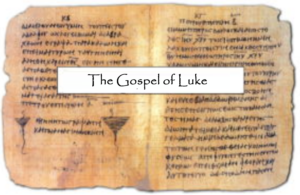
- Who wrote it? Luke, Paul’s faithful traveling companion.
- Where does it fit in God’s Great Salvation Story? As Paul was in prison in Caesarea waiting for his trial, before Paul’s journey to Rome, after Paul’s arrest in Jerusalem.
- Who were the original readers? Especially Gentile converts and Gentile seekers who did not understand much of the Jewish background of Jesus’ life and ministry.
- What was the situation that led Luke to write? Luke was writing to help Gentile Christians to understand the background of Jesus’ life, teachings and ministry. Luke wanted his readers “to know the full truth about everything they had been taught” about Jesus, clearly explaining Jewish religion and attitudes which a Gentile might not understand.
- What did Luke want his letter to change in his readers? Luke wanted Gentile converts to believe that God had revealed Himself finally and completely in Jesus and he wanted them to be confident that taking up their cross and following Jesus was worth whatever might come to them because of their faith.
After 2 years in prison in Palestine, Paul travels to Rome as a prisoner for trial
Paul’s Arrest in Jerusalem
After 2 years in prison, Paul was sent to Rome
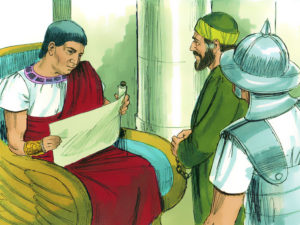
God gave Paul the promise that he would be able to testify about his faith in Rome, but it took a long time to get there. The governor kept Paul in prison for another 2 years! Finally, a new governor was appointed. Paul therefore requested that he be sent to Rome so that the Emperor of the Roman Empire could judge his case. He could request this because it was his right as a citizen of Rome and the governor agreed.
Paul’s Arrest in Jerusalem
Paul journeyed to Rome as a prisoner

Rome, however, was a 2-month journey away, so the governor assigned a Roman commander to guard Paul and a few other prisoners to travel by ship. They all boarded a ship headed to one island and then took another ship from that island that was sailing for Rome. Paul warned the Roman commander that it was the wrong time of the year and the ship would sink, but the commander did not listen. Paul in the end was right; a terrible storm sank the ship and Paul and the others on the ship were forced to stay on an island. After 3 months, they were finally able to take a ship to Italy. When their ship landed, they made their way to Rome, meeting many Christians along the way. For 2 years, Paul lived in Rome as a prisoner in his own rented rooms while he waited to stand before the Emperor to defend himself.
Paul’s Arrest in Jerusalem & Prison in Rome
Paul gave three letters to be carried by Christian friends to their destinations
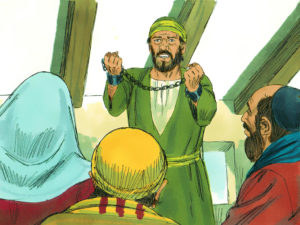
During Paul’s time as a prisoner in Rome, he wrote at least 2 letters to churches. One letter was to the Ephesians and another the Colossians. He also wrote a person letter to a man named Philemon. We can guess that Paul wrote these letters (Colossians, Philemon and Ephesians) because he knew someone was planning a journey and could carry them. In this case, there were two men—Tychicus and Onesimus—and they carried the letters to the Colossians, Ephesians and to Philemon. This was always the case, by the way. A person would inform one of the apostles that he was about to go on a journey and the apostle would write a letter and ask the person to bring it to Christians. Sometimes the letter was to all Christians (such as the letters from James, Peter and Jude); sometimes the letter was to a specific congregation, such as Paul’s letter to the Romans.
During these days of Gentile Idol Worshipers Begin Persecuting Christians
Gentile Idolators Persecute Christians
The Apostle John talks about persecution by Gentile idol worshippers
Gentile Idolators Persecute Christians
Many Gentiles in Ephesus and this area converted to Christianity

You may remember that Paul lived in Ephesus for almost 3 years. He started off preaching in the synagogue, but after a while some Jews spoke against what Paul was saying, so he left the synagogue and used a local lecture hall for teaching and preaching the gospel to Gentiles (non-Jews). That meant that people who became Christians in Ephesus were coming from idol-worshiping backgrounds and not from Jewish backgrounds. Paul was educating these new believers in the teachings of Jesus and training them in the gospel. After a while, Paul began sending them to other towns and villages to bring the good news there as well. Many more idol worshipers all throughout the area were believing the gospel and following Jesus Christ
Gentile Idolators Persecute Christians
Christianity started becoming a mostly Gentile Religion
We have already seen that at first, Christianity was a Jewish religious movement and most of the Christians were Jewish. When it was a Jewish movement, some Jews persecuted Paul and other Jewish Christians to keep their people from following Jesus. Now, however, Christianity had many more Gentile believers (non-Jews) rather than Jews and a more dangerous group of opponents rose up—families and communities of idol worshipers who wanted to keep people from converting to Christianity.
Paul’s Letter to Philemon
Paul’s Letter to Philemo
The Apostle John describes the interesting story of Philemon and Onesimus
Paul’s Letter to Philemon
Paul wrote a letter to Philemon to deal with the problem of a Christian escaped slave

The letter to a man named Philemon, who lived in Colossae, however, is especially interesting, because Onesimus (the person carrying it) was Philemon’s escaped slave. Onesimus had escaped to the city of Rome and somehow there in that city met Paul in prison. Paul had led him to faith in Jesus Christ and was now sending him back to his master with a letter, which we know as Philemon. Why did Paul write this letter? First, Onesimus (the escaped slave) needed to return to his owner. This was both Roman Law and also Christian responsibility. But second, Philemon needed to deal with the fact Onesimus was now a brother in Christ and Philemon had to deal with him differently. Paul seemed to be hinting that Philemon should consider setting Onesimus free and sending him back to Rome, as Paul’s helper in prison.
Paul’s Letters to the Colossians
Paul’s Letter to the Colossians
The Apostle John explains the situation in the Colossian Church
Paul’s Letters to the Colossians and the Ephesians
Paul’s Letter to the Colossians

Christians in the town of Colossae, a town which was about a 4-day’s journey from Ephesus were mixing their former non-Christian religious practices with Jewish and Christian religious practices. These newly converted Christians did this because they were afraid of demonic attack, something they understood from their old religions they had left. They did not understand that Christianity was not a religion, but a personal relationship with Jesus Christ, the mighty Son of God. Therefore, Paul wrote his famous letter to the Colossians, a gentle but firm letter to help them understand what it means to belong to Jesus Christ, the crucified and risen Lord over all the earth and heavens.
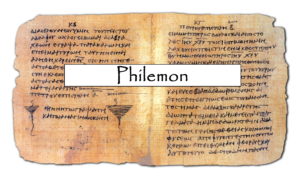
- Who wrote it? Paul
- Where does it fit in God’s Great Salvation Story? During the rise of persecution by Gentile idol worshipers after Paul had been arrested in Jerusalem and then taken to Rome to stay in prison before he was released from prison after two years.
- Who were the original readers? A Christian named Philemon who lived in Colossae along with the believers who met together in his house.
- What was the situation that led Paul to write? Philemon’s slave, Onesimus, had run away from and had somehow met Paul in Rome. Paul had sent Onesimus to be reconciled with his owner.
- What did Paul want his letter to change in his readers? That Philemon would forgive his runaway slave and love him as a brother in Christ.

- Who wrote it? Paul
- Where does it fit in God’s Great Salvation Story? During the rise of persecution by Gentile idol worshipers after Paul had been arrested in Jerusalem and then taken to Rome to stay in prison before he was released from prison after two years.
- Who were the original readers? Gentile converts who lived in the town of Colossae. They were confused about how Christians should deal with spiritual powers, both good and bad.
- What was the situation that led Paul to write? Some of the Christians in Colossae were using Jewish and some Gentile rituals and practices to bring themselves good luck and protection from spirits and unfriendly spiritual powers. These kinds of practices take away from Jesus Christ being Lord over all as the source of salvation and transformation.
- What did Paul want his letter to change in his readers? Paul wrote to help these Christians to see Jesus Christ as infinitely above all spiritual powers and for these Christians to realize that they were now IN CHRIST rather than under the power and authority of Satan and the spirit world. He wanted Christians to live like people who are now in the light of Christ rather than in the darkness of sin and shameful living.
Paul’s Letter to the Ephesians
Paul’s Letter to the Ephesians
The Apostle John explains why Paul wrote the Letter to the Ephesians
Paul’s Letters to the Colossians and the Ephesians
Paul’s Letter to the Ephesians

When idol worshippers converted to Christianity, the family and community would punish them. They might beat them or arrest them or burn their homes or possessions. Families would force converts to leave the house and would even disown them, saying they were no longer members of the family. The whole community might refuse to buy from Christian shops or might avoid hiring Christians to work for them. All of this was a way to pressurize Christians to come back to making the spirits happy, something God commanded Christians NOT to do. Converting to Christ led to a difficult life. Therefore, as he waited in prison in Rome, Paul wrote to the Ephesians to give them hope by reminding them of every spiritual blessing they had in Jesus Christ.

- Who wrote it? Paul
- Where does it fit in God’s Great Salvation Story? During the rise of persecution by Gentile idol worshipers after Paul had been arrested in Jerusalem and then taken to Rome to stay in prison before he was released from prison after two years.
- Who were the original readers? Gentile converts from idol worship who were being pressurized by family and community to turn away from following Jesus Christ and were rejected and persecuted by their families and community. These converts needed to leave their old ways behind and now to live according to Jesus Christ in holiness and good works.
- What was the situation that led Paul to write? Converts to Christianity had lost their families, their communities, and their identities. The world that the converts had left was a world of spirit and ancestor worship, a world of sexual immorality and corruption. Paul wanted believers to walk according to Christ in every part of their daily existence.
- What did Paul want his letter to change in his readers? Paul wanted these converts to understand the wonderful blessings they had received through Jesus Christ and to live according these blessings in their families, work, communities and all relationships.
Persecution from Gentiles gets worse
Persecution from Gentiles gets worse
The Apostle John talks about how dangerous persecution became
Persecution from Gentiles gets worse
Persecution was often not official but by mobs

As more and more Gentiles became Christians, persecution became worse. We have seen that some of that persecution was official, such as Paul’s arrests in Philippi or Jerusalem. Usually, however, persecution was local, either done by the family or the community. It came through riots or beatings or burnings of houses (there were no church buildings in those days). Officials might not do any official actions against Christians, but they might simply pretend to ignore killings or attacks against Christians.
Persecution from Gentiles gets worse
Peter moved to Rome and spent the rest of his life there

We have not mentioned Simon Peter for much of this story, because the book of Acts does not talk about him once Paul’s ministry began. Peter, however, was very active in the work of the gospel. At some point, Peter moved to Rome and preached there, probably during the very time that Paul was in prison in Rome. The non-Christians of Rome did not like Christians; the Romans called Christians atheists, because Christians did not believe in serving the spirits or the Roman gods. Up until this point, the persecution of Christians was mostly family and community, but it was about to become governmental as well.
.
Simon Peter’s First Letter
Simon Peter’s First Letter
The Apostle John talks about Simon Peter’s 1st Letter
Simon Peter’s First Letter
First Peter

Simon Peter wrote his book, 1 Peter, to prepare Christians for coming persecution. He was almost certainly in Rome when he wrote it. He wrote it to people who lived in the areas where Paul had preached the gospel 15 years before. Most importantly, he wrote it to help them know how to prepare for the coming persecution. Peter probably dictated this letter to Silvanus (i.e., Silas), one of Paul’s closest co-workers in missionary work.
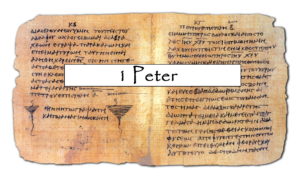
- Who wrote it? Simon Peter
- Where does it fit in God’s Great Salvation Story? During the rise of deadly persecution, after Paul was imprisoned in Rome the first time (he was apparently released from his first imprisonment and traveled to Spain), while Peter apparently remained in Rome preaching the gospel and discipling believers.
- Who were the original readers? This letter is written to Gentile Christians in the areas where Paul had preached during his first missionary journey. This letter was written to these believers perhaps 30 years after Jesus rose from the dead.
- What was the situation that led Simon Peter to write? Peter wanted to explain to Christians how they were to live among unbelievers and how to they were to deal with the coming persecution. He knew that deadly persecution was coming soon.
- What did Simon Peter want his letter to change in his readers? Christians were to live godly lives and show respect and love to non-Christians, even to those who persecuted them and treated them badly. Peter wanted all believers to be witnesses to Jesus Christ in all they did. And Peter wanted them to follow the example of Jesus Christ, in being ready to die at the hands of unbelievers so that these unbelievers might see Jesus Christ’s reflection and thus believe.
The Gospel of Mark
The Gospel of Mark
The Apostle John talks about how Mark wrote down his gospel
The Gospel of Mark
The Gospel of Mark: Peter’s preached Gospel
 Irenaeus, an early Christian who personally knew the Apostle John, wrote that “Mark also, the disciple and interpreter of Peter, himself handed down to us in writing the things which were preached by Peter…” Early Christians said that Peter had preached to the people in Rome and it had been written down. Peter himself said about the history of Jesus, “I will do my best, then, to provide a way for you to remember these matters at all times after my death.” The gospel of Mark is that way to help us remember.
Irenaeus, an early Christian who personally knew the Apostle John, wrote that “Mark also, the disciple and interpreter of Peter, himself handed down to us in writing the things which were preached by Peter…” Early Christians said that Peter had preached to the people in Rome and it had been written down. Peter himself said about the history of Jesus, “I will do my best, then, to provide a way for you to remember these matters at all times after my death.” The gospel of Mark is that way to help us remember.
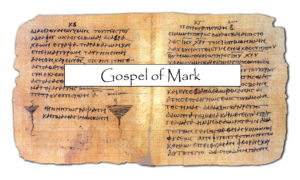
- Who wrote it? Mark, a disciple of Peter and Paul both
- Where does it fit in God’s Great Salvation Story?
Mark wrote this gospel at the end of Peter’s ministries, perhaps even partially after Peter was executed in Rome. This was a time when the ministry of the apostles began dying out. Now, the next generation would hear the message of Jesus Christ through the writings of the apostles. This gospel was probably written as persecution grew stronger, right before Peter’s and Paul’s final imprisonment and death
- Who were the original readers?
Mark wrote for believers and unbelievers: For believers who were facing persecution by the Roman Emperor Nero and needed assurance that Jesus Christ is the Son of God so they could follow Him no matter what the cost. Mark also wrote this gospel for Gentile unbelievers who needed a clear presentation of the story of Jesus, with clear explanations of Jewish customs.
- What was the situation that led Mark to write?
Peter was about to die and he wanted the next generation of Christians to know the history and key teachings of Jesus, so they could faithfully follow Jesus as well as also wanting Roman unbelievers to understand that Jesus Christ is the Son of God and died for their sins and rose again in glory.
- What did Mark want his letter to change in his readers?
Since Peter knew he was about to die (2 Peter 1:12-15), Peter wanted Mark to help the new generations to believe the Good News about Jesus Christ, the Son of God, to be courageous witnesses about Jesus to unbelievers and for unbelievers to come face to face with Jesus and follow Him as the crucified and risen Son of God.
Paul’s First Letter to Timothy and His Letter to Titus
Paul’s 1st Letters to Timothy & Titus
The Apostle John talks about Paul’s letters to Timothy and Titus
Passing the Mission to Next Generation
Paul was released from Roman prison

Around this time, after spending 2 years as a prisoner in Rome, Paul was released. We do not know the details, but we have very early Christian writings, such as 1 Clement, which say that after his release
Paul traveled from Rome to Spain, which would have been maybe a 15-day journey by boat.
At some point Paul came back from Spain and it seems that he traveled to Macedonia and ministered there.
Paul’s First Letter to Timothy and His Letter to Titus
1 Timothy

Paul almost certainly wrote 1 Timothy and Titus to prepare these men as leaders. These were young men who could carry on the mission of bringing the gospel to the ends of the earth. Young Timothy was Paul’s closest co-worker and Paul even included him as a co-writer of five of his letters. Now Timothy was pastoring the Christians in Ephesus and Paul wanted him to understand what ministry should look like. Paul’s letter 1 Timothy explained how churches should do the work of ministry and warned about false teachers who were already trying to lead Christians away from trusting in Jesus Christ alone to trusting in obedience to the Law. Paul’s letter to Titus who as serving as pastor on a large island with churches in many places.
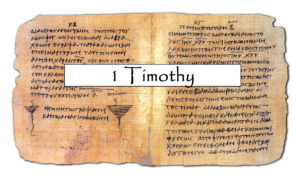
- Who wrote it? Paul
- Where does it fit in God’s Great Salvation Story? During the time of passing the ministry to the next generation, as persecution is growing stronger, before Paul’s final imprisonment and death
- Who were the original readers? Timothy, Paul’s beloved young co-worker in Christian ministry
- What was the situation that led Paul to write? Timothy was leading the Christians in the city of Ephesus and Paul want to give Timothy instruction in how to serve and also to warn him about how to deal with teachers of false doctrine.
- What did Paul want his letter to change in his readers? Paul wanted Timothy to be a wise and faithful leader of the Christians in Ephesus and to stop the spread of bad teaching which could harm Christians in the church.
Paul’s First Letter to Timothy and His Letter to Titus
Paul’s Letter to Titus

Paul also wrote to Titus who was serving as pastor on a large island with churches in many places. The people of that island had a reputation for dishonesty and laziness. Paul gave Titus instructions for choosing church leaders and especially for teaching Christians how they were to live as Christians.

- Who wrote it? Paul
- Where does it fit in God’s Great Salvation Story? During the time of passing the ministry to the next generation, as persecution is growing stronger, before Peter’s and Paul’s final imprisonment and death
- Who were the original readers? The people of Crete, a large island with a bad reputation for corruption and causing trouble. The churches in Crete seemed to be like their culture.
- What was the situation that led Paul to write? The churches needed godly leaders who could be models of Christ’s love and holiness, because the congregations were immature in their faith and corrupt in their lifestyles.
- What did Paul want his letter to change in his readers? Paul wanted Titus to appoint godly leaders who would model Christlikeness to the congregations. He also wanted Titus to tell the congregations to live pure and loving lives, living in peace with each other and their neighbors.
Passing the Mission to Next Generation
Passing the Mission to Next Generation
The Apostle John discusses how the apostles prepared the next generation for the mission
Passing the Mission to Next Generation
The Apostles prepare for the next generation by their gospels and letters

.At this point, most of the apostles were still alive and ministering. Peter was in Rome and early history says that Thomas was in India, serving near Taxila. James was still in Jerusalem. Bartholomew was preaching in Armenia. Matthew served in Persia. Within 15 years, however, many of these original apostles would be executed for their faith. Who would take their places in the work of the kingdom of God? A new generation of leaders had to be prepared.
Apostles Begin to Die from Persecution
Apostles Begin to Die from Persecution
The Apostle John talks about how persecution became dangerous in Rome
The Apostles begin leaving the Church thru Death
Persecution takes James, John’s brother, then James, Jesus’ brother

The first apostle to be executed was James, the brother of John. This happened about 10-12 years after Jesus rose from the dead. The next phase of persecution happened about 20 years later, when the Lord Jesus’ half-brother James was executed by the Jews in Jerusalem.
Apostles Begin to Die from Persecution
A great fire in Rome leads Emperor Nero to persecute Christians
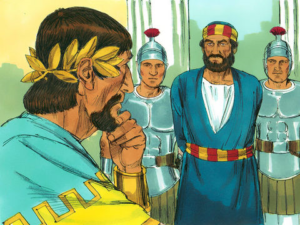 About 2 years after James was killed (34 years after Jesus’ resurrection), a terrible fire destroyed the city of Rome. Nero, the Emperor of Rome, was criticized for not doing enough to stop the fires, so he decided the shift the blame from himself to the Christians. Nero accused Christian believers of eating other humans, of committing incest and of being atheists (because Christians refused to worship Roman gods and spirits) and announced that Christians had started the fires. A terrible persecution broke out and hundreds and perhaps thousands of Christians were arrested and executed.
About 2 years after James was killed (34 years after Jesus’ resurrection), a terrible fire destroyed the city of Rome. Nero, the Emperor of Rome, was criticized for not doing enough to stop the fires, so he decided the shift the blame from himself to the Christians. Nero accused Christian believers of eating other humans, of committing incest and of being atheists (because Christians refused to worship Roman gods and spirits) and announced that Christians had started the fires. A terrible persecution broke out and hundreds and perhaps thousands of Christians were arrested and executed.
Apostles Begin to Die from Persecution
Simon Peter in prison realized he was about to die
 Often, Christians were dragged into stadiums where some were used as human torches, others were torn apart by wild animals and others were killed by gladiators (fighters who used spears, chains, swords and other weapons to kill them), all the while being ridiculed and laughed at by the thousands who sat in the stands watching the show.
Often, Christians were dragged into stadiums where some were used as human torches, others were torn apart by wild animals and others were killed by gladiators (fighters who used spears, chains, swords and other weapons to kill them), all the while being ridiculed and laughed at by the thousands who sat in the stands watching the show.
The Romans also arrested both Peter and Paul. We have seen that Peter’s first letter had warned that persecution was coming. His second letter was written when terrible persecution had now begun. In fact, Peter now told his readers that he himself would soon be put to death. His greatest concern was not for his own life, but for the church. False teachers had risen up and were teaching false doctrines and misleading believers away from faith in Jesus, and Peter wanted to protect the church from them.
2 Peter
2 Peter
The Apostle John tells about Peter’s final letter
Simon Peter and Paul’s Final Letters
Peter’s Final letter, 2 Peter

Since most of the apostles were now dying from persecution, how could the church stay pure without them? Peter’s promise was to make sure they would have a reliable account of Christ’s life and teachings, i.e., a gospel (the gospel of Mark). Also, Peter reminded them that they would need to rely on the Scriptures, both Old and New. Peter promised that the apostles’ stories about the life and teachings of Jesus were true and believers could trust what they said. He also encouraged them to read Paul’s letters. He called Paul’s letters “scripture” and warned his readers not to listen to people who distorted what Paul wrote. The apostles were dying, but their letters and gospels would continue to live and protect the church from error. Peter also said, “I will do my best, then, to provide a way for you to remember these matters at all times after my death.” He is probably talking about the Gospel of Mark. The earliest Christians said that Peter preached his gospel in Rome and Mark wrote it down.
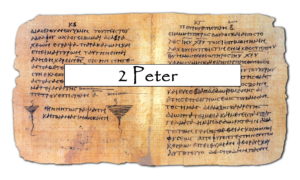
- Who wrote it? Simon Peter
- Where does it fit in God’s Great Salvation Story? During the time of passing the ministry to the next generation, as persecution is growing stronger, right before Peter’s and Paul’s final imprisonment and death
- Who were the original readers? Christians who were facing terrifying persecution by Emperor Nero and were also facing dangerous false teachers who were leading people away from trusting in Jesus Christ.
- What was the situation that led Simon Peter to write? Peter was about to die and he wanted the next generation of Christians to be faithful to what the Old Testament prophets had taught, to trust the life and teachings of Jesus as recorded in the gospels, and also to follow the teachings of the apostle Paul as recorded in his letters.
- What did Simon Peter want his letter to change in his readers? Since he was about to die, Peter wanted his readers to believe the Old Testament Prophets, the gospels, and Paul’s letters and to live according to their teachings and not allow themselves to be misled by false teachers.
2 Timothy
2 Timothy
The Apostle John talks about Paul’s inspiring letter to Timothy, his co-worker
2 Timothy
Paul’s final letter to Timothy before He Died

From prison, Paul wrote his final letter. It was very personal since it was written to his beloved co-worker Timothy. He wanted Timothy to keep preaching what he had learned from Paul and to teach those truths to other reliable preachers who would then teach them to others. Like Peter, Paul was worried about false teachers coming to the churches, teachers who would try to mislead the people to trust dangerous doctrines. Like Peter, Paul told Timothy that the only protection against such teachers would be to preach the Word. The churches needed to know that all Scriptures were breathed by God and reliable for teaching and training in righteousness.
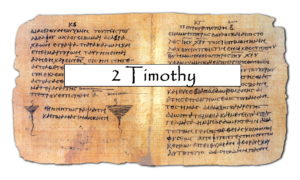
- Who wrote it? Paul
- Where does it fit in God’s Great Salvation Story? During the time of passing the ministry to the next generation, as persecution was growing stronger, right before Peter’s and Paul’s death
- Who were the original readers? Timothy, Paul’s beloved co-worker.
- What was the situation that led Paul to write? Paul is about to be executed in Rome and he understands that with his death Christianity must become a religion which relies on the Word of God, both Old Testament as well as the teachings of the apostles.
- What did Paul want his letter to change in his readers? Paul wants Timothy to be faithful in finding reliable people whom Timothy can teach God’s Word, people who will pass on that teaching to others.
Peter and Paul died during Nero’s persecution
Peter and Paul died during Nero’s persecution
The Apostle John discusses the deaths of Peter and Paul
Peter and Paul died during Nero’s persecution
Peter and Paul were both executed
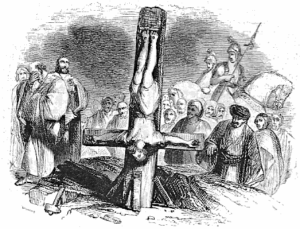
Paul asked Timothy to come to him in Rome before the end, but we don’t know whether Timothy got there in time. We know that shortly after he wrote this letter, Paul was executed, probably by having his head chopped off. Very early church tradition says that Peter was crucified (possibly upside down). We also know that at some point soon after this, Timothy himself was arrested and imprisoned.
Peter and Paul died during Nero’s persecution
Official persecution stopped, but local persecution continued

Within four years of the fire, Nero was dead, and the official Roman persecution stopped. We have already seen, however, that persecution did not need governors and emperors to be dangerous. Angry mobs might drag a Christian into the street and stone him or her to death or burn down the home of a Christian who refused to worship the spirits. Jews might try to force believers to deny Jesus as the resurrected Son of God. And many spirit worshipers or Jews would simply boycott faithful Christian believers, refusing to buy from them, hire them or work alongside them, even forcing Christians to leave their homes or villages.
Peter and Paul died during Nero’s persecution
Persecuted Jewish Christians consider leaving Christ

This was exactly the situation of Jewish Christians in those dangerous days after Paul and Peter were executed. Christians were facing a choice: curse Jesus as a false prophet in order to escape punishment and death or confess Jesus as the risen Son of God and risk losing everything including possibly even one’s own life
The Book of Hebrews
The Book of Hebrews
The Apostle John explains why Hebrews was written
The Book of Hebrews
Someone Wrote Hebrews to Compromising Jewish Christians

Some Jewish Christians began considering compromising. Perhaps they didn’t need to face persecution after all, since they were Jews. Why couldn’t they go back to being Jews without Jesus? Moses lived 1400 years before Jesus and he was saved; David lived 1000 years before Jesus and he was saved. These Jewish Christians wondered if they could simply stop believing in Jesus and go back to being Jews who went to the temple, prayed to God, and obeyed the Law? Someone (we don’t know who) wrote the book of Hebrews to Jewish Christians who were considering leaving Jesus Christ and returning to a Christless Judaism. We say that we don’t know who wrote Hebrews because all of Paul’s letters begin with the words, “Paul, an apostle…”, but Hebrews never says that. Hebrews does mention Timothy (and only Timothy), saying that Timothy has been in prison, but gives us no other names. Hebrews has a clear and powerful message: Now that the promised Messiah had arrived, there was only one pathway to God—Jesus Christ Himself.

- Who wrote it? It does not say…
- Where does it fit in God’s Great Salvation Story?
This unknown prophet wrote the Book of Hebrews when the apostles were beginning to die from rising persecution after Peter and Paul had died. Yet we are also pretty sure that Hebrews were written before the destruction of the Jerusalem Temple. Hebrews talks about priests and the temple as if they are still there, which was certainly NOT the case after A.D. 70.
- Who were the original readers?
The author of Hebrews was writing to Jewish Christians who were facing persecution and were considering abandoning their faith in Jesus Christ and returning to a seemingly safe but Christless Judaism (without calling themselves Christians).
- What was the situation that led the author to write?
Jewish Christians were wrongly assuming that if they went back to Judaism without Christ—as if the Messiah had never come—they could avoid persecution while still entering eternal life because of obedience to the Law (Temple, sacrifices, Sabbath, priests, etc.).
- What did the author want his letter to change in his readers?
The author wanted his readers to understand that because all of the Law pointed to Jesus Christ and had no meaning apart from Him, they could not abandon Christ and return to a Christless Judaism. They must hold on to Jesus no matter what!
Stage: The Rise of the New Testament and the Rise also of False Teachers
Rise of the New Testament & False Teachers
The Apostle John explains how the New Testament rose up
Stage: The Rise of the New Testament and the Rise also of False Teachers
Apostles in many different places die
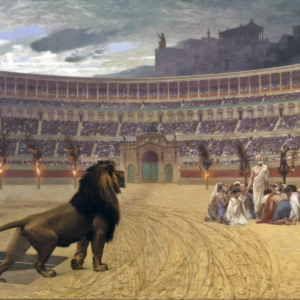
After Peter and Paul died (James Jesus’ brother and James John’s brother were already dead), one by one the other apostles were taken away. Early church traditions say that all but the Apostle John were executed for their faith, but we cannot be sure how they died, since we have different stories say different things.
Stage: The Rise of the New Testament and the Rise also of False Teachers
Christians have collections of letters from the Apostles
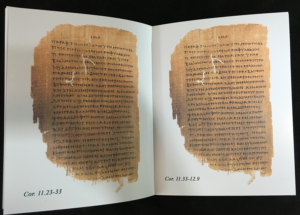
From the very beginning, Christians saw the apostles’ letters as Scripture. For example, when Paul specifically quoted from Luke’s gospel, he called it Scripture. It is clear from Peter that Christians were already collecting the letters of the apostles. Peter wrote, “Also, regard the patience of our Lord as an opportunity for salvation, just as our dear brother Paul has written to you according to the wisdom given to him. 16 He speaks about these things in all his letters in which there are some matters that are hard to understand. The untaught and unstable twist them to their own destruction, as they also do with the rest of the Scriptures.” (2 Peter 3:15–16) Peter called Paul’s letters Scripture and he assumed that Christians knew about “all” of Paul’s letters, which sounds like people were already collecting Paul’s letters and were reading them while Paul was still alive.
Stage: The Rise of the New Testament and the Rise also of False Teachers
The earliest Christians saw the Apostles’ Gospels and Letters as Scripture
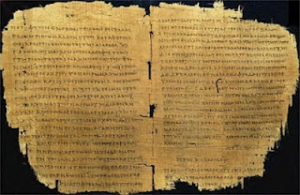
This makes sense since the earliest Christians who lived during the final years of the apostles (such as 1 Clement and the Epistle of Barnabas) quoted from either the gospels or letters because they saw them as scripture. Ignatius (who knew the apostle John) called John’s Gospel “Scripture” and the author of Barnabas called the Gospel of Matthew “Scripture”. Now that the apostles were gone, their letters and gospels (along with the Old Testament) took the place of the apostles to guide the church.
Stage: The Rise of the New Testament and the Rise also of False Teachers
False teachers misled many Christians
 However, not only were Christians reading the gospels and letters as Scriptures, they were also sometimes listening to false teachers. Paul and Peter had warned this would happen and before they died, both apostles wrote against false teachers who were misleading Christians. Sadly, as the number of apostles decreased, the number of false prophets and teachers began increasing in many places.
However, not only were Christians reading the gospels and letters as Scriptures, they were also sometimes listening to false teachers. Paul and Peter had warned this would happen and before they died, both apostles wrote against false teachers who were misleading Christians. Sadly, as the number of apostles decreased, the number of false prophets and teachers began increasing in many places.
The Letter of Jude
The Letter of Jude
The Apostle John talks about Jude’s letter
Jude wrote a letter about false teachers
The Letter of Jude

Jude, the half-brother of Jesus Christ, wrote a letter condemning these false teachers. Jude wanted his readers to “remember, my friends, what you were told in the past by the apostles of our Lord Jesus Christ.” He then quoted from 2 Peter. “They said to you, ‘When the last days come, people will appear who will mock you, people who follow their own godless desires.’” (Jude 18) Jude has several quotations from 2 Peter.

- Who wrote it? Jude, the brother of James and half-brother of Jesus Christ
- Where does it fit in God’s Great Salvation Story? During the rise of the New Testament and the rise of false teachers, after Peter and Paul had died, before the apostle John died.
- Who were the original readers? Christians living in the days after many of the apostles had died.
- What was the situation that led Jude to write? Now that most of the apostles were dead or living far
- What did Jude want his letter to change in his readers? Jude wanted Christians to be careful NOT to allow these false teachers to influence them and to fight for the original teachings, the faith which the apostles had handed down to all believers.
The Gospel of John
The Gospel of John
John Explains why he wrote the Gospel of John
The Gospel of John
John Wrote His Gospel for the Next Generation

50 years AFTER Matthew wrote his gospel, Christianity was now mostly Gentile and filled with Christians whose parents and even grandparents had also been Christians. False teachers were misleading many Christians and John decided to write a gospel which would tell the story of Jesus Christ’s ministry in Jerusalem and Judea (the province for Judah). While Matthew, Mark and Luke are almost completely in Galilee until the week of Jesus’ crucifixion, John’s gospel describes what happened when Jesus confronted the Jewish leaders in Jerusalem. Perhaps John saw the Pharisees’ hypocrisy and spiritual deadness growing among the Christians where he served.
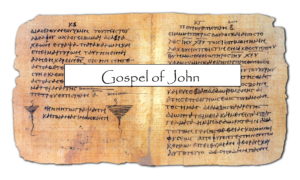
- Who wrote it? John, the son of Zebedee and brother of James
- Where does it fit in God’s Great Salvation Story? During the rise of the New Testament, after Paul & Peter had died and before John died
- Who were the original readers? Especially second and third generation Christians living in the days after many of the apostles had died as well as unbelievers.
- What was the situation that led John to write? False teachers had risen and were misleading Christians in their faith and Christians needed to understand who Jesus Christ is and what His coming and nature mean for a world darkened by sin and the lies of Satan.
- What did John want his letter to change in his readers? John wanted his readers to believe that Jesus is the Messiah, the Son of God and through believing to have life in His name and to understand what that means to the world and to believers.
John’s wrote 3 letters
1st, 2nd & 3rd John
The Apostle John explains why he wrote 1st, 2nd & 3rd John
1st, 2nd & 3rd John
Perhaps 50-60 years after Jesus rose from the dead, John wrote 3 letters.
 Early Christians wrote that John, son of Zebedee and brother of James, was the last of the apostles to die. In addition to his gospel, John wrote 4 letters to Christians, although generally people don’t think of the book of Revelation as a letter (it is a letter, however). John probably wrote 1 John, 2 John and 3 John around 50 to 60 years after Jesus rose from the dead. These letters are fighting against false teaching which believed that Jesus Christ had not come in real human flesh. He called all believers to believe the same gospel which had originally been preached to them when the gospel first came to them 40-50 years before (brought by the apostle Paul) and called them to reject these new ideas which were false.
Early Christians wrote that John, son of Zebedee and brother of James, was the last of the apostles to die. In addition to his gospel, John wrote 4 letters to Christians, although generally people don’t think of the book of Revelation as a letter (it is a letter, however). John probably wrote 1 John, 2 John and 3 John around 50 to 60 years after Jesus rose from the dead. These letters are fighting against false teaching which believed that Jesus Christ had not come in real human flesh. He called all believers to believe the same gospel which had originally been preached to them when the gospel first came to them 40-50 years before (brought by the apostle Paul) and called them to reject these new ideas which were false.
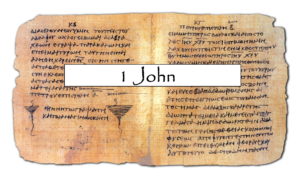
- Who wrote it? The Apostle John, son of Zebedee, brother of James
- Where does it fit in God’s Great Salvation Story? Written by the last apostle during the last 10 years or the first century, after the rise of the New Testament and the rise of false teachers and before John died.
- Who were the original readers? Christians who were being told by false teachers that they did not know God or the truth because they believed the original gospel rather than a new teaching.
- What was the situation that led John to write? False teachers who claimed that Jesus Christ had not come in the flesh as a real human being were trying to convince Christians to leave the church and following a new teaching.
- What did John want his letter to change in his readers? John wanted his readers to hold on to the truths which were originally taught to them 50 years before (when Paul had first preached the gospel, although John does not mention Paul) and to see that true faith does three things: believes that Jesus came in the flesh, practices righteous living and walks in love.
John’s wrote 4 letters
2 John

- Who wrote it? The Apostle John, son of Zebedee, brother of James
- Where does it fit in God’s Great Salvation Story? Written by the last apostle during the last 10 or 15 years of the first century, after the rise of the New Testament and the rise of false teachers and before John died.
- Who were the original readers? Although the letter says, “To the lady and her dear children…” the word “lady” here is probably a way of specifically talking about a local church congregation. These were Christians who were being tempted to join false teachers and leave the church.
- What was the situation that led John to write? False teachers were calling Christians to leave their churches and become “enlightened” and discover mystical “truths”.
- What did John want his letter to change in his readers? John wanted his readers to walk in love with one another and not to allow themselves to leave the teachings of Jesus Christ that they had originally learned and not to welcome into their homes anyone who brought false teachings.
John’s wrote 4 letters
3 John

- Who wrote it? The Apostle John, son of Zebedee, brother of James
- Where does it fit in God’s Great Salvation Story? Written by the last apostle during the last 10 or 15 years of the first century, after the rise of the New Testament and the rise of false teachers and before John died.
- Who were the original readers? A Christian named Gaius.
- What was the situation that led __ to write? John wanted Gaius to help Christian workers who were traveling and needed a place to stay.
- What did __ want his letter to change in his readers? John wanted Gaius to welcome Christian workers and wanted Gaius not to listen to a corrupt church leader who was trying to drive godly Christian workers out of the church.
The Revelation of Jesus Christ
The Revelation of Jesus Christ
John talks about the Book of Revelation
John’s wrote 4 letters
Revelation

The final letter of the New Testament was the book of Revelation. The Apostle John wrote Revelation as a letter to seven different churches in the province where he lived. John wrote “to show Christ’s servants what must happen very soon.” John described terrifying warnings to unbelievers of God’s coming judgment and promised wonderful hope to those who overcame the devil and his servants. The book is all about overcoming: overcoming Satan, overcoming fear in the midst of persecution, Jesus Christ overcoming sin itself through His cross (a major, major theme in this book). How should they overcome? Through the blood of the Lamb, through speaking their testimony about Jesus Christ to unbelievers, and through not loving their own lives, even if they die because of it.

- Who wrote it? Apostle John, son of Zebedee, brother of James
- Where does it fit in God’s Great Salvation Story? After the Rise of the New Testament and the Rise also of False Teachers, during the time when the Apostle John was writing the last books of the New Testament, before John’s death.
- Who were the original readers? Christians living in 7 different cities or towns all of which were about a two to three-day walk from Ephesus, where John was living. Some of these churches were experiencing terrible persecution, some seemed to be avoiding persecution and a couple of these churches were being influenced by the world or by bad teachings.
- What was the situation that led John to write? The book of Revelation showed Satan’s attack on God’s people through the world, a system of culture, finance, religion, sensual lust, desire, and pride. John revealed how Satan’s world was in rebellion against God and was persecuting God’s people, but only for a limited time, because final and complete judgment was coming. Most of the events in Revelation are still waiting to happen, but the message never changes—God will judge the world for its rebellion and depravity and Christians should not join into the world’s program.
- What did John want his letter to change in his readers? John wanted his readers to gain hope that Satan would not win, because the Lamb of God had defeated Satan and the world and would soon put an end to Satan’s evil rule over all humanity. He was telling God’s people to overcome Satan through Christ’s blood, through their open witness concerning Jesus Christ and by not loving their lives even if they would die.
John, the last Apostle, died about 70 years after Jesus’ resurrection from the dead
John, the last Apostle, died at the end of the first century
John, the last Apostle, talks about the New Testament
John, the last Apostle, died
Apostle John Died, Ending the New Testament
Somewhere around 70 years after Jesus rose from the dead, the Apostle John died. We know about his later life from 3 men who personally knew him and wrote about him (Ignatius, Polycarp and Papias). The story of the New Testament ended with John, but God’s Great Salvation Story continues on and will do through all eternity, as we await the return of Jesus Christ, when He fulfills the final prophecies and makes all things new.

